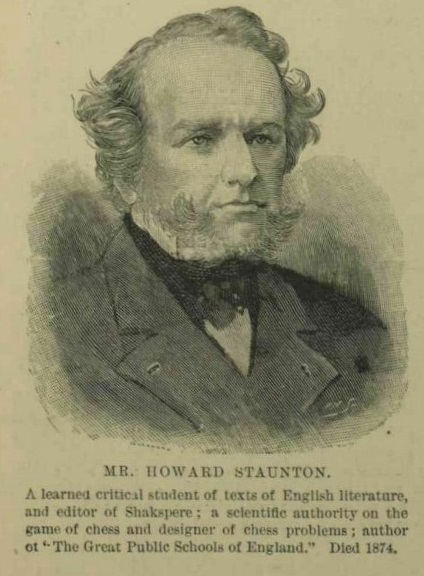
Edward Winter

Illustrated London News, 864 May 1892, page 598
The present general article on Howard Staunton does not repeat material in our existing articles on the Staunton v Morphy controversy, or in Attacks on Howard Staunton and Pictures of Howard Staunton.
A quote from George Walker’s pioneering work Chess Studies (London, 1844), page x:
‘In stating that I consider Mr Staunton to be at present the first English player, I sufficiently mark my opinion of the high qualities of his game. Brilliancy of imagination – thirst for invention – judgement of position – eminent view of the board – untiring patience – all are largely his. In Mr Staunton we are proud to recognize a champion worthy to succeed M Donnell. – Can praise go further?’
(7)
For an entertaining couple of hours or so, read through some of Staunton’s celebrated chess columns in the Illustrated London News. Some of his more ‘abusive’ Answers to Correspondents are quite well known. We give below a couple more:
‘J.K. Manchester. Assuredly Mr Staunton must be as much surprised as you can be by the announcement of a book of chess problems with his name as author, seeing that he has never made a chess problem in his life. The work turns out to be the wretched trick of a dishonest bookseller We should recommend any person who has been duped into buying this volume to proceed against the vender for obtaining money under false pretences.’ (24 January 1857)
What was the volume referred to?
‘For the hundredth time, at least, we repeat that a player on conducting his pawn to the 8th square is entitled to call for another queen even though his original queen is still on the board. Why do not chess amateurs, instead of writing to a newspaper for information on these simple matters, obtain some elementary book and learn the rules?’ (30 May 1857)
(91)
Regarding the 24 January 1857 column, we added this endnote on page 271 of Chess Explorations:
It seems that the only problem book published in 1857 was A Selection from the Problems of the Era Problem Tournament, prefaced by Löwenthal (published by T. Day, London). A German edition, Era-Schachproblem-Turnierbuch, appeared in Leipzig the same year. Any connection with Staunton remains to be established. Despite his use of the word ‘announcement’ it is more likely that Staunton was referring to a work of some five years previously. From page 34 of Betts’ Annotated Bibliography: ‘The Cleveland catalogue also has the following entry under Staunton, Howard: “Chess problems, consisting of upwards of seven hundred games and problems by the most eminent players: being the whole of ‘The Chess Player’s Chronicle’ for the years 1851 & 1852. 2 vols. in one. London, C. Skeat, 1852.”’ Has anybody ever seen a copy?
Why should the silly season not also invade the chess press? On page 90 of the August 1982 CHESS R. Hanna ‘reads your horoscope and names some famous players under their sign of the zodiac’. Some jaundiced souls may have found it hard to get past the first two sentences of the opening star-sign, Aries: ‘ARIES are bright and creative. Their weakness is in the endgame.’ Two typical Aries masters are then quoted: Smyslov and Portisch. We, however, were most grateful to R. Hanna. For no amount of historical research has ever revealed anything about the birth of Howard Staunton apart from the year: 1810. Yet astrology triumphs where historical investigators have failed; R. Hanna is able to reveal exclusively that Staunton was born under Cancer.’
(216)
From page 383 of the first volume of the Chess Player’s Chronicle (1841), a quote from Staunton which is of particular interest in view of his subsequent difficulties with Morphy:
‘Chess is unquestionably the finest game known; but still it is only a game; and one can entertain but a sorry opinion of his intellect, who makes it, or any amusement, the business of his existence.’
(596)
Addition on 28 August 2023:
John Townsend (Wokingham, England) quotes the words used by Saint-Amant about Staunton when writing about their first match in May 1843, on pages 203-204 of Le Palamède, 1843:
‘… j’attaque un homme qui, comme Labourdonnais, n’a pas d’autre occupation, d’autre sol à défricher que celui de l’échiquier; qui, de la tête aux pieds, est tout échec; qui y travaillait hier, qui y a rêvé cette nuit, et qui demain, après demain, n’a d’autre spécialité que celle-là. Moi, au contraire, je me partage; des occupations commerciales sont le sérieux de mon temps; les Échecs sont mon plaisir, mes distractions. Dans quelles conditions d’infériorité ne me présentais-je pas au combat!’
Our correspondent comments:
‘You will see that he finds in Staunton characteristics similar to those which had been deplored by Staunton himself some 20 months earlier in C.N. 596. Saint-Amant may have exaggerated a little in order to magnify his achievement in winning the match. I previously used this quotation on page 77 of my book, Notes on the life of Howard Staunton.
Later, Alphonse Delannoy made similar criticisms of Staunton at the time of the Paris match (Le Palamède 1843, pages 543-544), to which George Walker replied, pointing out that “his [Staunton’s] time is equally filled up with business matters as that of St. A.” (Chess Player’s Chronicle, 1845, page 93). However, Walker did not mention what “business matters” he was alluding to; he may have meant his work on the Chess Player’s Chronicle.’
In New in Chess issue 3/1986 the readers’ letters section suddenly comes alive with a series of excellent contributions on the Sphynx problem in Staunton’s Handbook.
(1190)
See also C.N. 12177.
Staunton wrote in the 1849 Chess Player’s Chronicle, page 48 (after 1 d4 e6 2 e4 d5 3 exd5 Qxd5):
‘The only advantage of taking the pawn thus, instead of in the way recommended by common sense, is that being likely to involve you in difficulties, it affords a charming opportunity for the display of ingenuity in extricating yourself afterwards.’
Quoted by D.J.Morgan, BCM, December 1954, pages 387-388.
Opinions are invited on whether Staunton had a sense of humour. Was his lacerating prose sometimes mere drollery?
(1283)
From G.H. Diggle (Hove, England):
‘Staunton’s jibe in the 1849 Chess Player’s Chronicle about the “charming opportunity for the display of ingenuity” was aimed at Edward Lowe, one of whose games against Capt. Kennedy he was annotating. Staunton displayed rather more humour as a raconteur than as a writer. He would solemnly relate absurd stories (never intended to be believed) either about himself or some other master.’
(1305)
From page 209 of the July 1899 BCM (in an obituary of G.A. MacDonnell by J.G.C.):
‘Staunton himself was a talker of repute; his stories were well told, his anecdotes pointed, and his humour flowed freely, albeit the stream might be somewhat turgid, and there was a general air about him which seemed to say, “When I ope’ my lips let no dog bark”.’
From W.D. Rubinstein (Aberystwyth, Wales):
‘Is anything more now known about the ancestry of Howard Staunton than when Keene and Coles’ biography appeared in 1975? According to the account in the Oxford Companion to Chess, “nothing is known for certain about Staunton’s life before 1836”. Have the Westmorland parish registers for the spring of 1810 ever been searched for a record of his birth? If he was not the illegitimate son of the fifth Earl of Carlisle, how did the rumour arise that he was, given that the Earls of Carlisle were not really household names among the English aristocracy? The fifth Earl (1748-1825) would have been 62 when Staunton was born. According to the Dictionary of National Biography he was a playwright of some note and was Chancery guardian to Lord Byron, which might be of relevance, given Staunton’s literary pursuits. There is no mention of Howard Staunton in his will. Could Staunton possibly have been the illegitimate son not of the fifth Earl, but of one of his sons – for instance of his third son Lord Frederick Howard, who was born in 1785 and was killed at Waterloo? Has any research been done with their wills?’
(1453)
From Ken Whyld (Caistor, England):
‘Among the many studies Hooper and I made for the Companion was to examine the Westmorland parish registers for every male child born of a father named William in the period March-September 1810. We also looked at every play-bill where Kean was in The Merchant of Venice and noted the Lorenzos. The secretary of the Earl of Carlisle is certain that Staunton was not of the family, and wills have been examined. I am sure, but cannot prove of course, that his original names were neither Howard nor Staunton. We know that he was, when young, greatly influenced by Kean, and a study of Kean’s life gives clues that show how Staunton might well have selected his name and circulated (in order to deny) the Earl of Carlisle bastard rumours. We took out death certificates for any William or Mary Staunton who died at a time which would fit their having been Howard’s parent, but only one turned out to be of the right sort of age. Birth and death certificates were issued only from 1837 onwards. Hooper made a map showing the place of death of every Staunton who died from the beginning of records in October 1837 up to December 1885. There were 240; none in Westmorland.’
(1471)
From pages 395-396 of Kings, Commoners and Knaves:
‘The names of Philidor and La Bourdonnais are destined to an immortality as lasting as the game of Chess itself; and, if the fame of M. Des Chappelles should prove less enduring, it will not be from inferiority of genius, but the misfortune which has preserved for posterity so few of his remarkable achievements.’
Howard Staunton, the Chess Player’s Chronicle, 27 November 1847, page 378.
(7069)
Louis Blair (Keyser, WV, USA) submits a position discussed on pages 26-27 of The Chess-Player’s Handbook by Howard Staunton (various – but all? – editions):
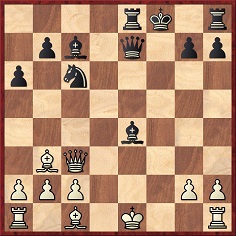
Staunton writes:
‘White is enabled to castle, giving check to the adverse king at the same time, and win the game easily, for Black has no square to which he can move his king without going into check, and is consequently obliged to interpose his Q. at K.B’s second or K.B’s third square [f7 and f6 respectively], in either case being checkmated in two more moves, as you will soon be able to see.’
Our correspondent wonders where the mate in two is after ...Qf6.
(2073)
In his Times column on 1 October 1999 Raymond Keene wrote, in amongst all the customary blank space, that Howard Staunton ‘had also embarked on a history of the English Public School system that remained unfinished when Staunton died in 1874’.
However, before us lies the first edition of The Great Schools of England, a 517-page book which was published in London in 1865. A quote from the Introduction (pages xxi-xxii) offers some characteristic Staunton prose:
‘Education in England is at present very much of a chance-medley affair. It has neither unity of object nor of spirit. The whims of individuals, the bigotry of sects, the timid interference of the Government, the tricks of charlatans, sciolism, incompetency, coarse popular feeling, and necessity, all commingle and counteract. What fruits can such a system, or rather such an absence of system, bear? A Minister of Public Instruction would not, it is true, eradicate the whole evil, would not provide a perfect remedy, but he would be an efficient instrument of a great reformation. He would potently help to bring order and unity; he would infuse energy, and would compel even the most recalcitrant and incapable to follow a comprehensive plan. In this country there is a dislike, and a very proper dislike, to that bureaucratic meddling which is the bane of Continental States. But we sometimes suffer as much from the want of centralization as other nations do from its excesses. By all means let bureaucracy, which is the pedantry of despotism, be opposed. Let no dread, however, be entertained of centralization where education is concerned; for vigorous centralization would quicken and stimulate public instruction, enlarge its scope, and hasten its march.’
And from pages xxxvi-xxxvii:
‘Of all the chief modern languages, English is perhaps the worst spoken and the worst written by educated people. It is written too often with an almost total disregard of euphony, elegance, and even grammar; and it is spoken mincingly or mouthingly, with countless horrible disfigurements. Why should not English be written with as much of precision and propriety and classical finish as French? Why should not Englishmen speak as accurately as Frenchmen? We need not, in England, as respects language, be apprehensive of becoming purists; the danger lies in the opposite direction. Pedantry in speech is an evil; barbarism in speech is a greater evil …
That a boy should be able to speak and write his native language as it ought to be spoken and written, is of more solid and lasting importance than that he should excel in the composition of Greek and Latin verses; yet many a boy can do the latter, who is utterly incompetent to the former.’
(Kingpin, 1999)
The young Morphy’s well-known ‘devilish bad games’ disparagement of Staunton did untold harm to the Englishman’s reputation in the twentieth century. As G.H. Diggle pointed out in C.N. 1932, P.W. Sergeant gave currency to the gibe in three of his books (Morphy’s Games of Chess, Morphy Gleanings and A Century of British Chess).
The remark was subsequently seized upon by various anti-Staunton writers. Here, for example, is a paragraph from page 3 of Al Horowitz’s book from the early 1970s, The World Chess Championship A History:
‘About Staunton as a player it is perhaps impossible to be strictly objective: it is just too incredible that anyone seemingly so weak as he could have achieved such success and exerted such influence for so long. When the book of the tournament at London in 1851 came into the hands of the then 15-year-old Morphy, the lad felt moved to scribble on the title page, under the legend declaring it to be “By H. Staunton, Esq., author of the ‘Handbook of Chess’, ‘Chess-player’s Companion’, etc.” the irreverent parenthesis “(and some devilish bad games)”. Devilish bad they certainly are, and share with their author’s prose style a turgidity that is truly exasperating. The real secret of Staunton’s success was that he picked his opponents carefully – how carefully will soon become apparent. Only once in his life did he fail to be careful enough.’
In Morphy’s Games of Chess (page 5) Sergeant quoted C.A. Buck as the source of the ‘devilish bad games’ story. For the record, we cite below what appeared on pages 7-9 of Buck’s book, Paul Morphy. His Later Life (published in Newport, Kentucky in 1902):
‘As a matter of fact, Morphy did not at any time have the benefit of chess books in the sense of keeping a number of them at hand for study and reference. What few books he made use of he went through quickly [sic] as possible, and after having mastered the contents he gave them away. James McConnel [sic], the elder, of New Orleans, has a book of the tournrment [sic] of 1851 which Morphy gave him when 15 years old. The book had been issued but a short time when Morphy secured this copy. He soon played over all the games and then gave it to his friend. The volume is especially interesting on account of numerous marginal notes in Moprhy’s [sic] own handwriting by which he expressed his opinion of the games and certain moves. As is well known, this book was edited by Staunton, and young Morphy, like a child of genius, made a captious comment on Staunton’s chess play by writing on the title page to make the authorship read like this: “By H. Staunton, Esq., author of the Hand-book of Chess, Chess-Player’s Companion, etc. (and some devilish bad games)”.’
The Buck booklet (30 small pages) was brought out by Will H. Lyons, who wrote in the ‘Publishers Prface’ [sic]:
‘C.A. Buck of Toronto, Kansas is the author of this interesting and comprehensive biography of Paul Morphy. Mr Buck has gathered from authentic sources facts and data in the later life of Morphy that have never been published. Several years were devoted to securing information; a month was then spent in New Orleans verifying and adding to his store of facts; Morphy’s relatives and friends giving him great assistance. The matter first appeared in a prominent Western newspaper. With Mr Buck’s consent, I now offer it in its present form …’
Paul Morphy The Pride and Sorrow of Chess by David Lawson (pages 213-215) gave further particulars of the genesis of Buck’s work and commented that it ‘appears to be responsible for a number of erroneous statements that have been widely accepted’. Lawson listed many examples, but had not mentioned Buck earlier (i.e. on page 42) when (unquestioningly) relating the ‘devilish bad games’ matter.
On page 54 of The Human Side of Chess Fred Reinfeld asserted that Buck was ‘a subsequent owner of Morphy’s copy’ of the Staunton tournament book, but we recall no other claim that the volume owned by James McConnell (1829-1914) passed into Buck’s possession. Nor do we know what happened to McConnell’s books when he died (in New Orleans on 21 November 1914). Perhaps C.N. has a reader in New Orleans who could investigate further.
(2885)
C.N. 2885 included a passage from pages 7-9 of Paul Morphy. His Later Life by C.A. Buck (Newport, 1902):
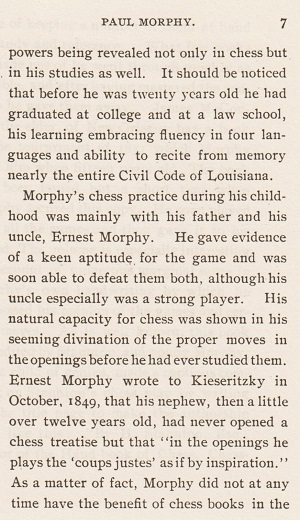
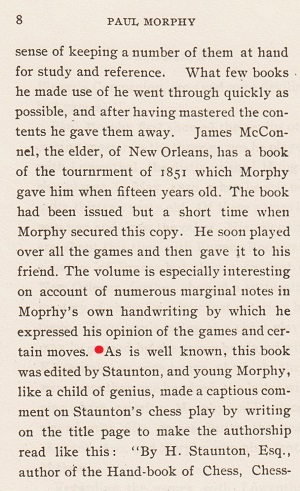
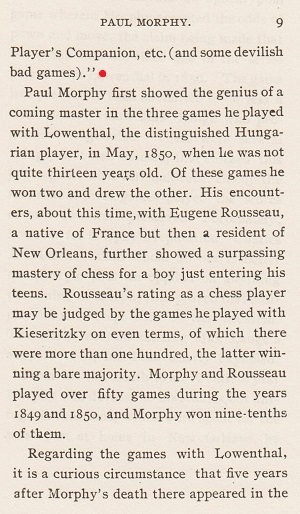
Buck’s text on Morphy had been published on pages 1-7 of the American Chess World, January 1901, introduced as follows:
‘We reprint from the Evening Gazette of Cedar Rapids, Iowa, a biographical sketch of the life of the immortal Morphy, by Mr C.A. Buck, of Toronto, Kansas, who is one of the most enthusiastic and best known chess experts in the Middle West.’
On page 214 of his 1976 biography of Morphy, David Lawson gave 29 December 1900 as the date of the article’s appearance in the Evening Gazette. Can any reader provide a copy?
(10293)
The Cleveland Public Library has provided the article referred to in C.N. 10293 (Evening Gazette of Cedar Rapids, Iowa, 29 December 1900, page 9):
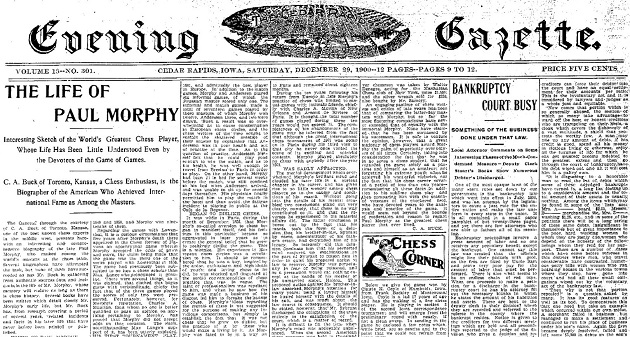
(10353)
As pointed out in C.N. 155, page 3 of Ray Keene’s Good Move Guide by Raymond Keene and Andrew Whiteley (Oxford, 1982) had, in the very first paragraph, ‘damned’ instead of devilish.
A rare example of [Staunton] being lauded beyond his homeland [at that time, i.e. circa the 1950s]. The text comes from page 137 of Les échecs dans le monde by Victor Kahn and Georges Renaud (Monaco, 1952):
‘Howard Staunton a été non seulement le précurseur de Steinitz et de son époque, mais encore il laisse pressentir le style actuel d’un Botvinnik. Il est regrettable que la gloire factice d’un Anderssen, porté au pinacle par ses compatriotes, ait fait oublier – tout au moins hors de la Grande-Bretagne où son traité se lisait encore avant la première [sic] guerre mondiale – la profondeur des conceptions du champion anglais, conceptions tout à fait surprenantes pour ce temps-là.
Mais Staunton, à son époque, était unique et il n’y avait pas, pour apprécier son style, un climat et un public.’
(3283)
Frank Camaratta (Toney, AL, USA) reverts to a matter outlined in C.N. 360: the court action taken by John Jaques & Son, Ltd. against CHESS after the magazine’s 14 September 1937 issue featured an advertisement for ‘genuine Staunton chessmen’, whereas they had not been manufactured by Jaques. CHESS lost the suit, but won on appeal. In addition to the article by Fred Wren mentioned in C.N. 360, an account of the affair by Gareth Williams on pages 28-31 of CHESS, September 2001 may be noted.
Mr Camaratta asks for a copy of the offending advertisement, as his 1937 issues of CHESS are in bound form and lack the covers (where the magazine’s advertising material appeared). Our own copies for the 1930s are also bound and coverless, but a reader will certainly be able to show us exactly what appeared in issue 25 of CHESS to provoke what the magazine later called (on page 351 of the July 1939 number) ‘the chess lawsuit of a century’.
(3653)
Andy Ansel (Walnut Creek, CA, USA) has sent the back-cover advertisements which appeared in CHESS, 14 September 1937 and 14 October 1937:
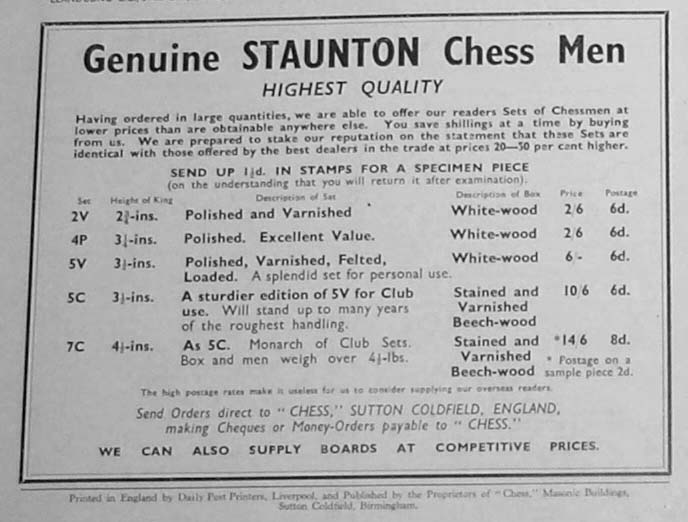
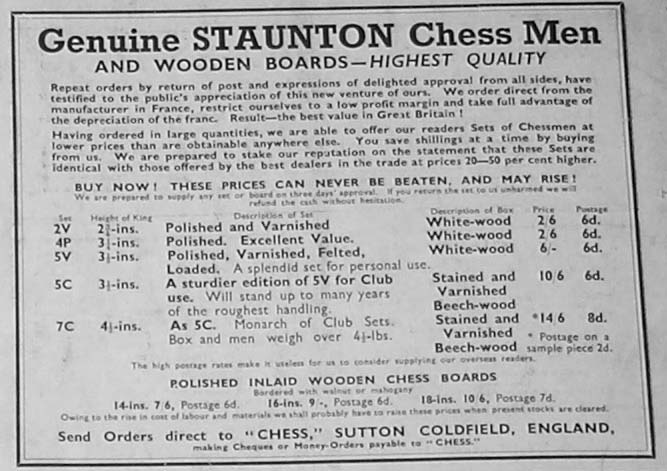
(3656)
See Chess in the Courts.
As mentioned in C.N. 4843, on pages 240-245 of the July 1883 BCM W.N. Potter reviewed Chess Life-Pictures by G.A. MacDonnell (London, 1883).
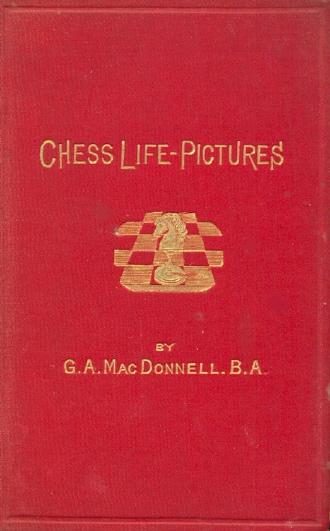
A comment by Potter about the coverage of Staunton:
‘The author has evidently a great admiration of Staunton, and the consequence is a portrait painted in the brightest colours, virtues exaggerated, faults minimized, and gravest flaws suppressed. Very graceful and attractive is such magnanimity on Mr MacDonnell’s part for he was at one time violently, not to say virulently, attacked by the object of his laudation. Horwitz says of Staunton, “I never liked his principles, but he was always a man”. The author quotes and tries to attenuate this criticism; but Horwitz meant what he said, and I think all impartial judges must agree with him. Staunton, however, had splendid talents and, what is much to his credit, they were self-cultivated. The sketch given of him in this book, though highly coloured, is so far real that it gives us a good idea of Staunton in many respects and particularly in those mannerisms and characteristics which constitute the visible man.’
(4844)
Milan Ninchich (Macquarie, ACT, Australia) enquires about the original price of the first Jaques club-size Staunton set (dated 1849) and asks what is known about the boxes which Staunton signed and numbered by hand.
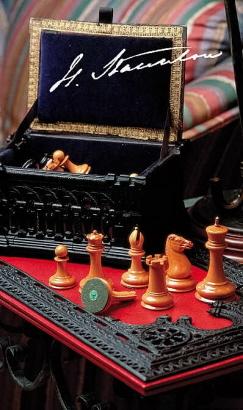
We consulted the owner of The House of Staunton, Frank Camaratta (Toney, AL, USA), who is writing a book entitled The Staunton Chessmen and their Predecessors. Mr Camaratta has informed us:
‘The original plan was to have Staunton hand-sign and hand-number 1,000 (or possibly 999) of the manufacturer’s paper labels, which were affixed to the bottom of the boxes of Jaques chessmen (wood, ivory, both sizes), and it is known that he signed at least 600, as I have seen specimens with numbering that high. Here is a label from set number 488:
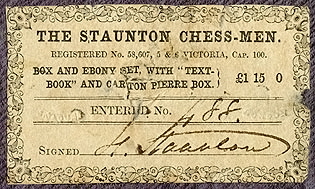
It shows the price of an unweighted boxwood and ebony set with a 3-3/8” king in a carton-pierre casket: £1 15s 0d
The label below is from the large club-size chessmen (4-3/8” king):
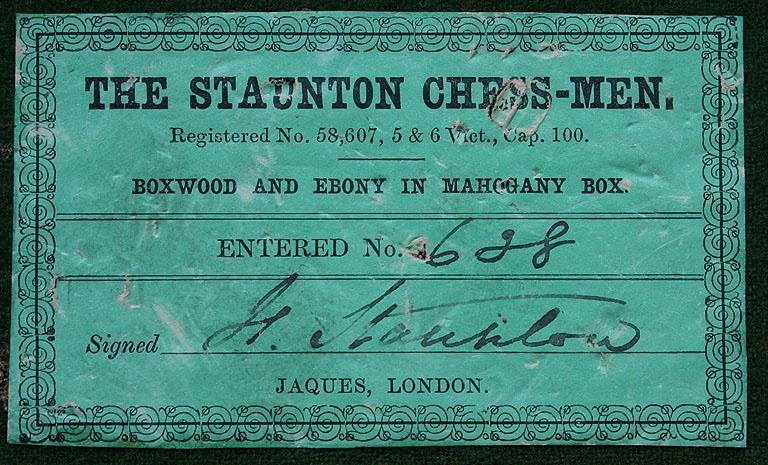
The price of the club-size set, loaded with lead, was £2 5s 0d. By contrast, the club-size set made from African ivory was £9 9s 0d in the extra-large carton-pierre casket and £10 10s 0d in a Spanish mahogany case with two partitioned fitted trays for the chessmen. I have seen hand-numbered labels as low as 10.
There was a series of numbered labels which followed, all having a facsimile signature of Staunton and a printed Entered (production) Number. The labels came in three colors: green, yellow and red. The green labels were found only on wooden sets, all sizes, in mahogany hinge-top boxes and were numbered from 1,000 (1,001?) to 1,999. I have seen labels numbered between 1,009 and 1,975. The yellow labels bore numbers from 2,000 to 2,999 and were found only on carton-pierre caskets which housed the smaller (2-7/8” and 3-3/8” kings) unweighted Jaques boxwood and ebony sets. The weighted sets (which were made only in the 3-3/8”, 4” and 4.4” king sizes) could not be housed in the carton-pierre caskets since they would “break through” the sides of those relatively fragile caskets. Finally, the red labels bore numbers from 3,000 to 3,999 and were reserved for ivory sets. Ivory sets were housed in carton-pierre caskets (of which there were three sizes), blue velvet-lined mahogany boxes and the large-fitted (Spanish) mahogany caskets. After that, the labels were not numbered.
There is also a story surrounding the small green round registration stickers found under the bases of the earlier Jaques chessmen.
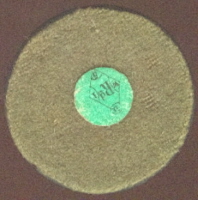
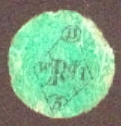
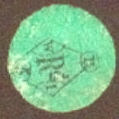
These gave the class and date of registration for the design. There were actually three designs, and not one as is commonly believed. Two had errors and may well become valuable. There was also a short run of early Jaques labels bearing the incorrect registration number.’
Readers may wish to note that Mr Camaratta has a new company, The House of Staunton Antiques, LLC. He has kindly supplied all the illustrations for the present item, including this final one:
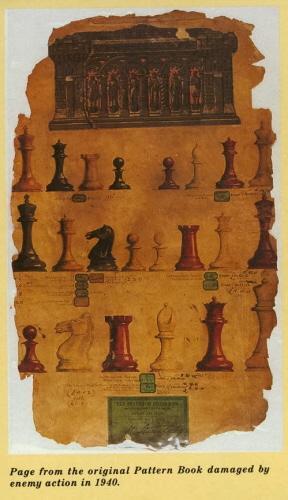
(5104)
Jon Crumiller (Princeton, NJ, USA) sends the first advertisement for the Jaques Staunton set, on page 223 of the Illustrated London News, 29 September 1849:

Our correspondent also reports that he possesses a (framed) letter written by Staunton on 8 August 1847 (and headed ‘Chess Champion’):
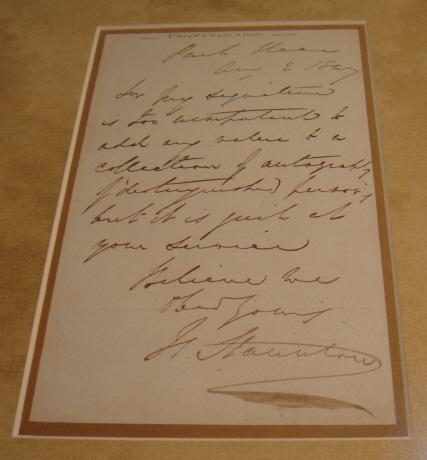
The body of the letter reads:
‘My signature is too unimportant to add any value to a collection of autography of distinguished persons but it is quite at your service.’
(5111)
John Townsend asks whether it is known where Howard Staunton was living at the time of the 1841 census.
The three addresses in our Where Did They Live? feature article come from later on:
Here we add that pages 411-414 of the September 1891 BCM reproduced in facsimile form an 1858 letter written by Staunton to Charles Tomlinson. The address was 2 Leigham Avenue, Streatham, Surrey.
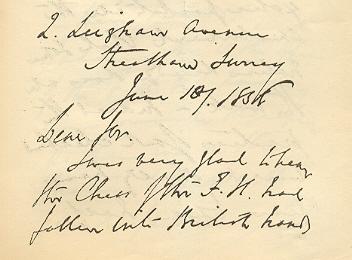
It is worth noting in this context a passage from page 101 of Paul Morphy The Pride and Sorrow of Chess by David Lawson (New York, 1976):
‘Just how soon Morphy met Staunton is not known, but evidently it was on 23 or 24 June [1858] because he enjoyed Staunton’s hospitality at his country home at Streatham that weekend, as Edge mentions in one of his letters.’
Page 226 of David DeLucia’s Chess Library. A Few Old Friends by D. DeLucia (Darien, 2003) shows part of a four-page letter from Staunton to Fitz-Cook in which Staunton’s address was 27 Chilworth Street, Hyde Park, London. The letter is undated but the opening comment (‘With regard to the Chess World Magazine. Although I doubt whether a periodical solely devoted to chess will ever be a very lucrative undertaking ...’) suggests that it was written in the second half of the 1860s, when he was the editor of Chess World.
Thus the earliest address on hand is from 1849, at the time of his marriage, but where did he live during his bachelor days? The year of interest to our correspondent, 1841, was when Staunton began the Chess Player’s Chronicle, and it may be supposed that he wrote many letters. Have any survived?
(3979)
Michael Clapham (Ipswich, England) draws attention to a footnote on page 49 of A Century of British Chess by P.W. Sergeant (London, 1934):
‘Staunton later [i.e. after 1832] had a house at Richmond; but I have not been able to trace when Staunton’s association with the neighbourhood began.’
Our correspondent also mentions that one of the addresses given in C.N. 3979 (2 Leigham Avenue, Streatham) appeared in an 1850s letter from Staunton reproduced on page 110 of Howard Staunton Uncrowned Chess Champion of the World by Bryan M. Knight (Montreal, 1974). The exact year of the letter is not easy to read.
In connection with Knight’s book we add that when, in 1974, Albrecht Buschke sold copies of the limited hardback edition he added for his customers a facsimile of a letter from Staunton to Tassilo von Heydebrand und der Lasa, written from 8 Sydney Place, Brompton on 20 January 1851. From Buschke’s transcript it will be seen that Staunton referred to the astronomer H.C. Schumacher, who was discussed in C.N. 3976, and that he misspelled both Heydebrand and Lasa.
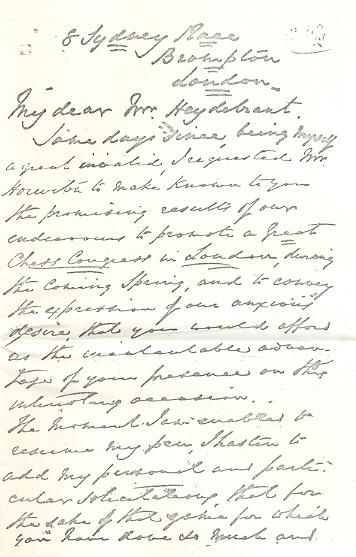
‘8 Sydney Place
Brompton
LondonMy dear Mr Heydebrant,
Some days since, being myself a great invalid, I requested Mr Horwitz to make known to you the promising results of our endeavour to promote a Great Chess Congress in London, during the coming Spring, and to convey the expression of our anxious desire that you would afford us the incalculable advantage of your presence on this interesting occasion.
The moment I am enabled to resume my pen, I hasten to add my personal and particular solicitations, that for the sake of the game for which you have done so much and, I may add, sacrificed so much, you will not suffer any insurmountable impediment to prevent your being present at this striking and unique assemblage – Already from all parts of England, from France, from India & America we have the most gratifying manifestations of sympathy and support, and on all sides there is an anxious longing expressed to learn [hear?] that you will take part in a Congress so fraught with important consequences to the future prosperity of chess.
Do my dear Sir exert yourself to gratify the wishes of the chess community – I wrote to you some weeks ago on [an?] account of our early proceedings through our dear, lost, friend Mr Schumacher, but his illness prevented his communicating with you. In a few days I will send you a programme of the intended assemblage – but, in the meantime, I entreat you to give me the assurance that you will join us. This [That] assurance will induce hundreds to join our standard and infuse the greatest animation through all ranks of players both here and abroad. Should you determine to come, I will later care that you are subjected to conveniences (?) on the score of a residence. London will doubtless be disagreeably full & I have many visitors, but on hearing of the month when you propose coming I will take you comfortable apartments in the neighbourhood of the Town – and on your arrival will meet you in company of Mr Horwitz to convey you from the Railway to my house and from thence to your abode (?).
Anxiously awaiting your reply and with best compliments
I subscribe myself
My dear Sir,
Faithfully yours
H. StauntonHerr Von Heydebrant der Laza
Jany. 20th 1851.’
Page 181 of the 1851 Chess Player’s Chronicle referred to the absence from the tournament of Heydebrand und der Lasa, ‘who, to his deep regret, was unable to leave his diplomatic duties’.
(3984)
From John Townsend:
‘Howard Staunton was commemorated in 1999 by a blue plaque at 117 Lansdowne Road, Notting Hill, London:
“HOWARD STAUNTON 1810-1874
British World Chess Champion
lived here 1871-1874”I believe the dates contain an inaccuracy in that he did not live there until 1872. In my book Notes on the Life of Howard Staunton, published in 2011, his place of residence between 14 February 1872 and 1 April 1872 is clearly traced on pages 153-154 through the contents of four letters which are cited:
- 14 February 1872: written from 27 Chilworth Street;
- 13 March 1872: written from 27 Chilworth Street: he is “in treaty for a house near to St John’s Church, Notting Hill”;
- 15 March 1872: written from 27 Chilworth Street: he extends an invitation to his new home when he moves into it;
- 1 April 1872: written from 117 Lansdowne Road: he moved in “last Saturday”.
Consequently, Staunton did not reside at 117 Lansdowne Road until Saturday, 30 March 1872.
The above-mentioned English Heritage webpage states:
“Staunton’s plaque was therefore erected at 117 Lansdowne Road, where he lived from late 1871 until spring 1874, shortly before his death.”
In the light of the four letters mentioned above, it would be interesting to know what evidence exists for the “late 1871” part of this statement and for “1871” on the plaque.’
(11883)
An addition from John Townsend on 21 April 2023:
‘I wrote to English Heritage to advise them of the error and I recently received a reply from the Senior Historian, Blue Plaques. My research was accepted as “conclusive”, and it was acknowledged that the dates 1872-1874 should have appeared on the plaque, and not 1871-1874.
It was explained that the “arrival date came from the chess writer R.N. Coles”. (He died in 1982.)
The reply also stated that once a plaque is made and installed, there is no correcting it. However, the webpage has been amended to reflect the error.’
From page 149 of How to Play Chess Like a Champion by F. Reinfeld (New York, 1956):
‘Staunton was pompous and bombastic, a self-appointed dictator of the chess world. On one occasion a rival published a statement that he had won the majority of his games with Staunton. The next time they met Staunton thundered, “You can’t print that!” His rival stammered feebly that the statement was true. “What’s that got to do with it? Of course it’s true!”, Staunton raged. “But you still can’t print it!”’
In C.N. 1624 (see pages 132-134 of Chess Explorations) we quoted Chernev’s version of the anecdote in The Bright Side of Chess, as well as a (significantly different) account by G.A. MacDonnell in the Illustrated Sporting and Dramatic News. In both cases Staunton’s rival was named as Löwenthal. Do any other nineteenth-century sources discuss the alleged episode?
(4030)
See too Chess Anecdotes.
On page 11 of The World’s Great Chess Games (New York, 1951) Reuben Fine wrote about Howard Staunton:
‘He wrote, he played, he traveled all over, lecturing and giving simultaneous exhibitions.’
In fact, Staunton shunned simultaneous play, as mentioned in C.N. 594 (see pages 237-238 of Chess Explorations), which quoted the following passage from his column on page 371 of the Illustrated London News, 14 April 1866:
‘We have often expressed our opinion of “that silliest of all chess exploits” – the playing a number of games simultaneously against a number of tenth-rate amateurs. To play half-a-dozen games without sight of the chessboards is a real tour de force of which very few are capable. To play half-a-hundred by merely parading up and down before as many chessboards is what any tolerable player can do without difficulty. In such a case, he need only be insensible to the absurdity of the exhibition; and if he is a good walker, or if he can hire a velocipede, his triumph is infallible.’
What detailed records exist of Staunton playing simultaneous chess?
In his Psychology book (page 30) Fine wrote of Staunton, ‘No brilliant games of his have survived ...’, a remark characteristic of much that used to appear about him in US chess literature. Other examples were quoted in our feature article on Frederick Edge; for a particularly ill-natured paragraph about Staunton by Al Horowitz see page 259 of Chess Facts and Fables.
(4492)
C.N.s 594 and 4492 (see too pages 237-238 of Chess Explorations) mentioned Staunton’s aversion to simultaneous displays, as expressed on page 341 of the Illustrated London News, 14 April 1866:
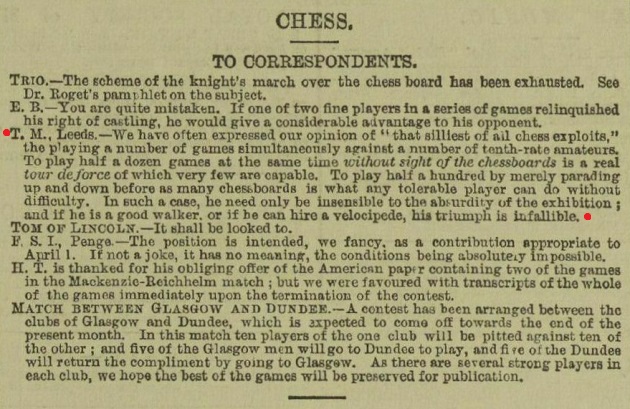
The difficulty in establishing Morphy’s non-blindfold simultaneous activities was referred to in C.N. 10423.
(11874)
See also C.N.s 11939 and 11992, as well as the following:
Jerry Spinrad (Nashville, TN, USA) informs us that the only simultaneous display by Staunton which he has seen mentioned in the Chess Player’s Chronicle is a very small one at the Rock Ferry Chess Club (July 1853 issue, pages 217-218):
After supper and speeches the games were resumed, but the report did not specify the outcome.‘A special Meeting of this Society was held on the evening of the 5th ult. at the Club Rooms, Rock Ferry Hotel, for the purpose of welcoming to Cheshire Mr Staunton, who, during his short visit, was the guest of Mr Morecroft, of the Manor House ... In the course of the evening there was some very interesting play. Mr Staunton conducted simultaneously two games against the Liverpool gentlemen, in consultation at one board, giving them the odds of pawn and two moves, and against the Rock Ferry gentlemen, at another board, giving them the odds of the knight.’
On Morphy, Jerry Spinrad and John Townsend refer to a simultaneous display which is well known. Mr Townsend writes:
‘David Lawson, in Paul Morphy, the Pride and Sorrow of Chess (new edition by Thomas Aiello, 2010), quoted (on pages 213-214) from an account of a simultaneous exhibition which took place at the St James’s Chess Club in London on 26 April 1859, the source being the Illustrated News of the World, of “the following Saturday”:
“A highly interesting assembly met in the splendid saloon of St James’s Hall, on Tuesday evening last [26 April], when Mr Morphy encountered five of the best players in the metropolis.”
The opposition was formidable:
“The first table was occupied by M. de Rivière; the second, by Mr Boden; the third, by Mr Barnes; the fourth, by Mr Bird; and the fifth, by Mr Löwenthal. Mr Morphy played all these gentlemen simultaneously, walking from board to board, and making his replies with extraordinary rapidity and decision. Although we believe that this is the first performance of the kind by Mr Morphy, it is a remarkable fact that he lost but one game. Two other games were won by him and two were drawn.”’
Those reports, one display apiece by Staunton and Morphy, are all that can currently be cited here, although the following may be recalled from C.N. 10423 (concerning Morphy after his match with Anderssen):
‘He confined himself to simultaneous displays, playing 20, 30 and even 40 people at once ...’
Source: page 274 of Keene On Chess by R. Keene (New York, 1999). The identical wording was on page 275 of Complete Book of Beginning Chess by R. Keene (New York, 2003).
(11996)
Richard Reich (Fitchburg, WI, USA) writes:
‘A fantasy series by George R.R. Martin (four volumes so far) is popular. The latest volume, A Feast for Crows, refers to a noble family named Staunton and has a character named Alekyne. Martin was once a tournament director for Bill Goichberg’s Continental Chess Association in the United States.’
(4608)
The following account by G.H. Diggle originally appeared in Newsflash, August 1980 and was republished on page 60 of Diggle’s book Chess Characters (Geneva, 1984):
‘Chess History contains many shadowy episodes on which only an uncertain light has been shed, chiefly because the sources of information lie in musty volumes now so rare that only eccentrics know where to find them. The six games played in London in May 1843 between Staunton and Saint-Amant (six months before their Great Match in Paris) are a case in point. The scores were all preserved and the result (St A. 3, S. 2, Drawn 1) is not disputed – but did the games constitute a set match, or were they, as Murray claims, “six informal games which the Frenchman afterwards magnified into a chess match”?
Staunton (Chess Player’s Chronicle, 1843) published the games, but said nothing about a match, and informed his readers that “they were of inferior quality, affording nothing like a test of the relative skill of the two players”, that “he had entered the arena for the first time after severe indisposition”, that he ought to have won the second game “without difficulty” and the fifth “easily”, and that in the sixth game “the timidity, so foreign to Mr S.’s usual style of play, which he exhibits in this contest is undoubtedly attributable to the state of his health”.
But Saint-Amant (Palamède, 1843), though he certainly “went to town” over his victory, is full of praise for the sportsmanship both of his opponent, who was “parfait de courtoisie” throughout, and of “la galerie” at the St George’s Chess Club – “comme beaux joueurs et vrais gentlemen les Anglais très certainement sont nos maîtres”. Moreover, his six-page account fairly established that, though hurriedly arranged and for a nominal stake of one guinea only, it was in fact a match, the winner of the first “trois parties” to be declared the victor, draws not counting. The arrangements at the St George’s, St A. informs us, showed commendable “savoir-vivre” – two “obligeants amateurs” sat recording the moves, and an “honorable assistance” instantly conveyed them to “une nombreuse réunion” who eagerly awaited them with chess sets at the ready in an adjoining apartment.
The first game (Sicilian Defence) was won by Staunton as Black after 69 moves and four hours; the second (Bishop’s Opening) was drawn after 90 moves and six hours, the third and fourth (two Giuoco Pianos of 36 and 30 moves played at one sitting resulted in one game all): the fifth (Sicilian) won by St A. after 60 moves and six hours; and the sixth and deciding game (QP Dutch Defence), won by Saint-Amant after 58 moves (adjourned on 52nd move after 6½ hours – duration of final session not recorded, but Staunton occupied 57 minutes over his 56th move). The games themselves show that Staunton (though scarcely in the debilitated state he says he was) did not reveal the subtle positional strategy that he used with such effect in the later and greater match. The best game of the earlier series is probably the drawn one, a fine struggle which was included by R.N. Coles in Battles-Royal of the Chessboard (1948).’
(4706)
Richard Holmes (London) writes:
‘I have been looking up Howard Staunton (1810-74) in the various genealogical resources now available on-line.
In the 1871 census Howard and Frances Staunton were recorded at Gad’s Hill, Northfleet in Kent, but I cannot find that place on a modern map; the Gadshill where Charles Dickens once lived is not far away, but surely could not be described as Northfleet. Howard Staunton’s occupation was given as “professional writer” and his birthplace as Keswick, Cumberland (rather than Westmorland, as seen in other sources). The reference is RG10/897/69/21.
In the 1861 census the couple were visiting the sisters Emma and Martha Englehart in Isleworth. Howard Staunton was recorded as “Author (scientific & general literature)”, and his birthplace was given as “in the Lakes” (RG9/771/50/12).
In the 1851 census Staunton and his wife were at 8 Sydney Place, Kensington with two of her relatives and two servants. He was described as “Journalist and Annuitant”, his birthplace being recorded as Westmorland (HO107/1469/322/33).
I cannot find Howard Staunton in the 1841 census.
As is well known (and is confirmed by www.familysearch.org), he married Frances Carpenter Nethersole on 23 February 1849 at St Nicholas, Brighton. However, a further fact derived from that website which I have not seen noted is that Frances Carpenter and William Dickenson Nethersole had no fewer than eight children baptized at St Clement Danes between 1826 and 1842.
The baptismal entries for 1810 at Crosthwaite, the parish that included Keswick, were also consulted via the above-mentioned website; they show around 40 male baptisms, but none named either Howard or Staunton. None of this throws any real light on Howard Staunton before the first documented appearance generally quoted (1836) but may offer clues for further research.
The obituary in The Times, 30 June 1874, page 8, quoted a press release from the Athenaeum which appears to be the source for several of the “facts” about his life, e.g. that he attended Oxford without taking a degree and that he once played Lorenzo to Kean’s Shylock.’
(4776)
Sean Robinson (Tacoma, WA, USA) asks whether detailed research has been undertaken into claims that Staunton was an actor.We believe that the best treatment of the subject, though still inconclusive, is by John Townsend on pages 25-30 of Notes on the life of Howard Staunton (Wokingham, 2011).
(10461)
From John Townsend:
‘If the story is true that Howard Staunton played Lorenzo to Edmund Kean’s Shylock, a likely venue is the small theatre at Deptford, for the reasons given on page 26 of my 2011 book Notes on the life of Howard Staunton.
One small development since 2011 has been identification of a performance in which Kean played Shylock at Deptford. Page 3 of the Morning Post of 14 March 1831 reported that Kean had played that role in The Merchant of Venice at the Deptford Theatre the previous Saturday, 12 March, for the benefit of a Mr Ormond, to a full house.
I have not discovered who took the part of Lorenzo. If a playbill for the performance has survived, it should contain the name of the actor, but none has been located so far.’
(10466)
From the chess section on page 18 of The Boardgame Book by R.C. Bell (Los Angeles, 1979):
‘[Staunton] designed a board in 1843 which has since become the standard European board.’
(4827)
A feature on page 104 of Fred Reinfeld’s The Treasury of Chess Lore (New York, 1951) entitled ‘Morphy’s Estimate of Staunton’ was taken from page 410 of the September 1891 BCM, but the latter offered no source. For that, and a more extensive version, we turn to page 155 of Paul Morphy The Pride and Sorrow of Chess by David Lawson (New York, 1976):
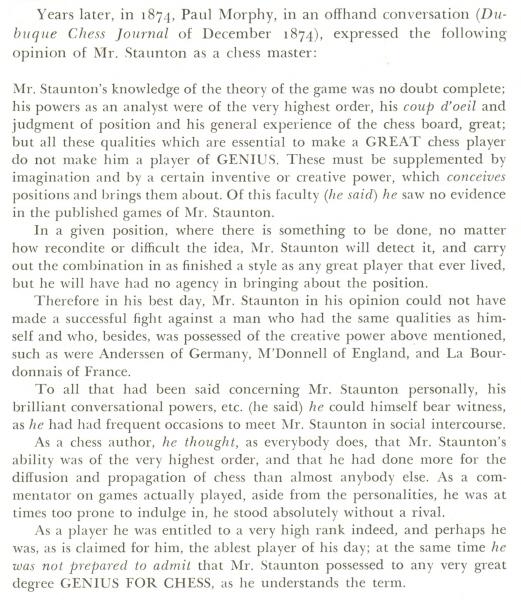
Is a reader able to supply the item as it appeared in the Dubuque Chess Journal or in any other source during Morphy’s lifetime? We should like to know the exact context and circumstances of this ‘offhand conversation’.
(5008)
Below, courtesy of the Cleveland Public Library, is the item published in the Dubuque Chess Journal:

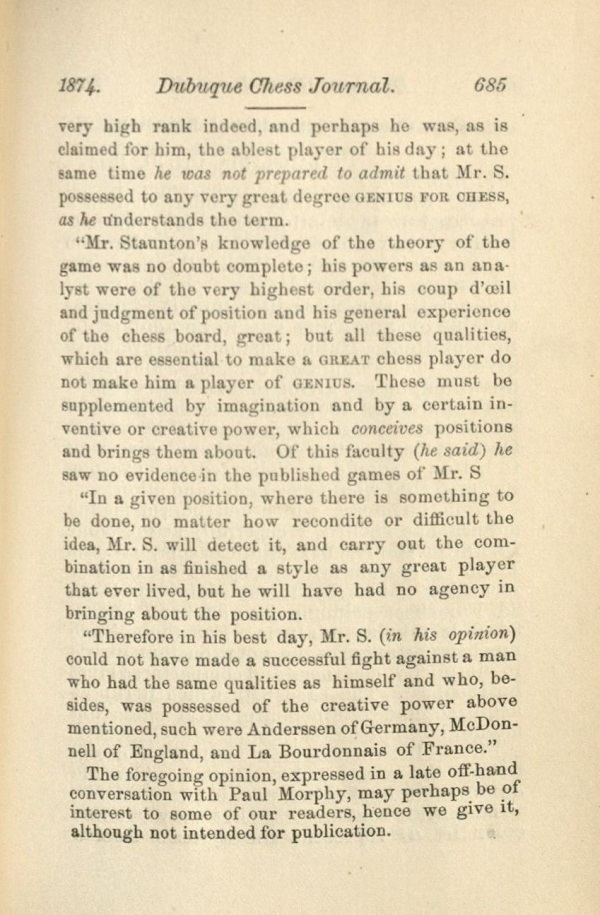
Jon Crumiller sends a cutting from page 4 of the Wisconsin publication the Whitewater Register of 31 July 1858. Readers are naturally advised to treat it with great prudence.
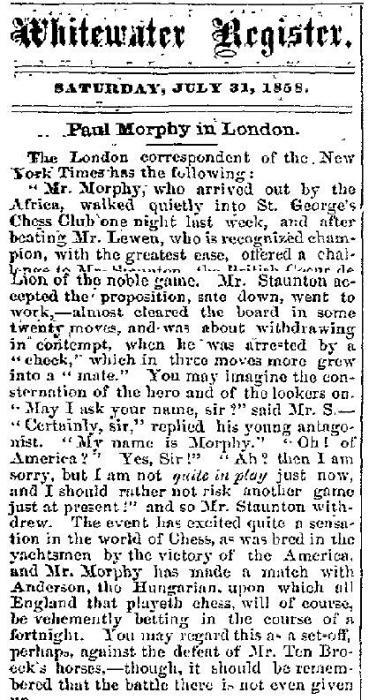
(5283)
From the obituary of Howard Staunton on pages 232-234 of the August 1874 Huddersfield College Magazine:
‘... Mr Staunton had the sole charge of the weekly chess column in the Illustrated London News since its commencement in 1842, for which, if we are rightly informed, he received a very handsome stipend. Some idea may be formed of the labour which devolved upon him in this connection from the fact that his correspondence, as he himself stated to the writer of this article, averaged 700 letters weekly.’
(5488)
John Townsend notes that the Huddersfield College Magazine was incorrect to state that Staunton’s column in the Illustrated London News began in 1842, the right date being 1845.Our correspondent forwards two quotes from the Illustrated London News:
‘We have great pleasure in announcing to our chess subscribers and readers generally that we have secured the valuable services of Mr Staunton, the eminent chessplayer, to edit the chess department of the Illustrated London News.’
‘“Scacchi”, Glasgow must be aware that the gentleman to whom he directs his comments is not in any way responsible for the errors which may be found in this department of our paper prior to 22 February ...’
(5492)
From page 105 of the Chess Player’s Chronicle, 1841 (an answer by Staunton to a correspondent):
‘“XYZ, BRAINTREE”: We reply to every communication that reaches us: our correspondent’s letter was not received.’
(5513)
Three correspondents offer information about Howard Staunton’s standing as a Shakespearean scholar.
Hassan Roger Sadeghi (Lausanne, Switzerland) draws attention to the Shakespeare’s Editors [link broken] webpage on Staunton, which quotes from the entry on the latter in the 1909 edition of the Dictionary of National Biography.
Robert John McCrary (Columbia, SC, USA) refers to the 1979 edition of Staunton’s work published by Park Lane, New York:
‘The Foreword, by Solomon J. Schepps, comments on page xiv that Staunton:
“... was one of the great Shakespearean scholars of his age. His knowledge of the texts themselves and of Elizabethan language and customs was enormous. And, equally to his credit, he understood the importance of including extra material in this edition.”
However, in the 1969 Pelican Shakespeare I can find no mention of Staunton, although other nineteenth-century volumes by other editors are cited.’
From William D. Rubinstein (Aberystwyth, Wales):
‘Staunton’s name can be found in modern reference books on Shakespeare, but only briefly and not invariably. For instance, he does not appear at all in Shakespeare’s Lives by S. Schoenbaum, the standard work on how Shakespeare has been discussed and examined since his death. Staunton’s views on the meaning of a word in Shakespeare are occasionally cited in recent editions of the plays, such as the Arden and Oxford publications, but, again, not often.’
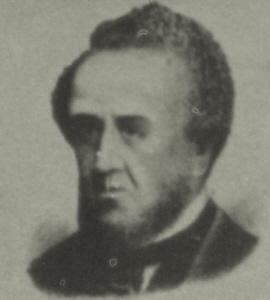
Howard Staunton
Finally for now, we add a brief item from page 81 of the February 1888 BCM:
‘In the course of a speech which Mr Routledge, the eminent publisher, made lately at a complimentary dinner, he paid a high tribute to the literary abilities of the late Howard Staunton, and stated that his firm had paid that gentleman £1,000 for editing his edition of Shakespeare. The work was a labour of love on the part of the great chessplayer, but nevertheless the payment would be welcome.’
(5516)
From Richard Allen (Cambridge, England):
‘The commentary on this subject in C.N. 5516 indicated that while Howard Staunton was a Shakespearean scholar and editor of considerable learning and distinction in his own time, his contribution to this field is only briefly and occasionally recognized today. This is unsurprising, given that Shakespeare studies have become a mass global industry in the modern age. Indeed, one aspect of this development, large collaborative projects supported by prestigious institutions, was already under way in Staunton’s own day. His three-volume edition of Shakespeare’s plays (1858) may have earned him £1,000 but it was a labour of love on the part of a self-taught, unaffiliated amateur. It nevertheless won plaudits for its careful and judicious collation of available texts, as well as for other virtues to which I shall return. Unluckily, however, it was rather overshadowed by the appearance only five years later of The Cambridge Shakespeare (1863-66), edited by W.G. Clark, J. Glover and W.A. Wright. This publication, according to J. Isaacs on pages 305-324 of Shakespearian Scholarship, A Companion to Shakespeare Studies by H. Granville-Barker and G.B. Harrison (Cambridge, 1934), “was the great landmark [in Shakespearean scholarship] of the mid-century ... Its rigorous system of collation was facilitated by [Edward] Capell’s superb bequest of quartos to Trinity College’ (page 314). Two further landmarks of collaborative scholarship, J.J. Furness’s New Variorum Edition and the foundation by F.J. Furnivall (“a team-leader”, according to page 315 of Isaacs’ work) of the New Shakspere [sic] Society, followed in 1871 and 1872 respectively. By comparison with these monumental enterprises, Staunton’s achievements must already have appeared somewhat modest by the time he died in 1874.
That, however, is by no means the whole story. Both The Cambridge Shakespeare and Furness’s Variorum were produced by academic specialists for an academic audience; they were tomes to be consulted mainly in university libraries. Staunton’s edition, by contrast, was produced for the general public, first appearing – like a Dickens novel of the same period – in shilling monthly parts. And again like a Dickens novel, only more so, it contained an abundance of distinctive illustrations; there were some 831 sketches by John Gilbert, all engraved by the Dalziel brothers, making Staunton’s edition, according to Peter Holland – see page 65 of volume one of Performing Shakespeare in Print: Narrative in Nineteenth-Century Illustrated Shakespeares, Victorian Shakespeare by G. Marshall and A. Poole (London, 2003) – “the most popular of mid-nineteenth-century illustrated Shakespeares”. The combination of popular appeal and editorial standards that were still acceptably high accounts for its twentieth-century reprint (referred to in C.N. 5516), which remained in print until the early 1990s – “an extraordinary longevity for any Shakespeare edition”, as Holland remarks (volume one, page 67).
There were many illustrated Shakespeares published in the nineteenth century, but in even some of the more notable, such as Charles Knight’s National Edition of 1851, the pictures tend to be undramatic and de-contextualized. In Staunton’s edition, on the other hand, Gilbert’s prodigiously numerous sketches are embedded in the text, providing dramatic vignettes from various distances and perspectives, and foregrounding character. Thus, argues Holland, was “created a dramatic narrative of performance, as close an interconnection between illustrations and the performed text ... as the century could ever have hoped to achieve” (Marshall and Poole, volume one, page 71).
While naturally keen to represent Gilbert as “the powerhouse for the edition” (Marshall and Poole, volume one, page 68), Holland acknowledges Staunton’s “decent and honourable” editing (page 68) and notes that a few of his emendations have retained acceptance among modern editors. The tribute is very much to the point but perhaps understates Staunton’s achievement. The main reason for the small number of emendations retained today is that Staunton actually proposed only a few. This was in keeping with the deliberate modesty and moderation of his whole editorial approach, in which a wide range of available readings has been considered but the oldest (quarto) ones usually adopted unless there is a strong case against. Staunton’s methods need to be seen in the context of the sensational forgeries perpetrated by a leading Shakespearean of the day, J. Payne Collier. In 1853, Collier published Notes and Emendations to the Text of Shakespeare’s Plays, in which he listed marginal annotations in a seventeenth-century hand purportedly discovered in a copy of the Second Folio he had bought in a bookshop. The authenticity of this discovery was soon questioned, but the document and numerous others that Collier claimed to have found were not conclusively proved to be forgeries until 1859. In a detailed account of this shocking case in the Preface to the 1860 edition of his Shakespeare, Staunton states that he himself instigated the scrutiny of the fabricated documents by Sir Frederic Madden, N.E. Hamilton, and other professional “paleographers” at the British Museum; he was prompted, he says, by a sense of responsibility to have the issue determined before his own editorial project saw the light of day. The investigation took longer than anticipated because of Collier’s obstructiveness, but it is clear that Staunton’s commitment to “decent and honourable” editing was reinforced by Collier’s gross transgression of such standards. Staunton’s other major publication in the field, Memorials of Shakespeare (1864), a collection of photolithographic facsimiles of extant documents such as the dramatist’s will and the indentures of conveyance and mortgage of his house, can be seen as similarly motivated by a desire to help restore the values of fidelity and authenticity to popular Shakespeare scholarship.
The essay on Staunton on pages 319-321 of volume 52 of the new Dictionary of National Biography by H.C.G. Matthew and Brian Harrison (Oxford, 2004), an updating by Julian Lock of Sidney Lee’s original article, recognizes his immense contribution to the world of chess while noting flaws of personality displayed therein – for example, his tendency to become involved in vendettas and the hint of class snobbery betrayed in his leadership of St George’s feud with the London chess club. It is interesting that such weaknesses seem much less evident in Staunton the Shakespearean. In his strictures on Collier’s malpractice he does not resort to personal denigration, and he even deprecates the undue “stringency” of a previous attack on the wretched forger. And though largely forgotten today, his own distinctive achievement in this field was to produce a reputable version of Shakespeare in an accessible and attractive format.’
(5603)
C.N. 4870 invited readers to identify the person whose obituary stated that ‘a man of his literary distinction is an honour to the game’ – a nineteenth-century figure who died in his sixties and was known not only for his activity in the chess world (e.g. the Chess Player’s Chronicle and the Illustrated London News) but also for his writings on Shakespeare as from circa 1860.
It was not Howard Staunton (1810-74) but Clement Mansfield Ingleby (1823-86). Below is the complete obituary published on page 416 of the November 1886 BCM:

(4876)
An annotational disagreement occurred between Staunton and Saint-Amant regarding two positions in the 16th game of their match in Paris, played on 11 December 1843.
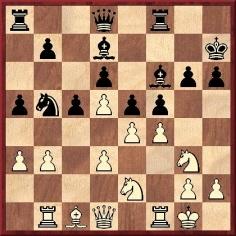
Here, Staunton played 20 exf5, and Saint-Amant commented on page 66 of the February 1844 issue of Le Palamède:
‘Ceci est un désavantage, car les 2P de la D doublés ne sont plus liés ensemble, et le plus avancé sera peut-être difficile à défendre.’ [‘This is disadvantageous, as the doubled d-pawns are no longer linked together, and the more advanced one will perhaps be difficult to defend.’]
Staunton quoted this in the Chess Player’s Chronicle, 1 April 1844, page 99 and responded:
‘Now we, on the contrary, opine that the taking this pawn increased the advantage in position which White had previously obtained.’
After 20 exf5 the game continued 20...gxf5 21 Nh5 Qe8 22 Nxf6+ Rxf6 23 fxe5 Qxe5.
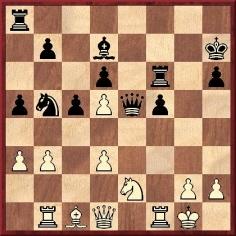
At this point Saint-Amant commented in Le Palamède:
‘Bien préférable à prendre du P. Les Noirs ont maintenant l’attaque, et leur jeu est supérieur à celui de leur adversaire.’ [‘Much better than taking with the pawn. Black now has the attack, and his game is better than his opponent’s.’]
In the Chess Player’s Chronicle, Staunton disagreed:
‘In the Palamède for February, page 66, note (6), we are gravely told at the present point, “Les Noirs ont maintenant l’attaque (!!), et leur jeu est supérieur à celui de leur adversaire” (!!!). We shall have much pleasure in affording the Editor of Le Palamède an opportunity of verifying this, to us, somewhat startling assertion; and for the purpose, we undertake, on his next visit to London, to play White’s game against him from this move, half-a-dozen times, for as many guineas as he may think proper to risk on the result.’
Saint-Amant reverted to these matters on pages 164-168 of the April 1844 issue of Le Palamède. Concerning 20 exf5 he maintained his standpoint, adding that it was a question of theoretical principle on which most experts would agree with him. (‘Nous ne voyons pas dans les paroles de M. Staunton le moindre motif de rien changer à ce que nous avons dit. Ceci est une question de principe théorique, sur laquelle nous ne craignons pas d’avancer que nous aurons certainement la majorité des connaisseurs de notre côté.’)
As regards the second position, Saint-Amant maintained that Black had the attack, whilst adding that it was a matter of taste:
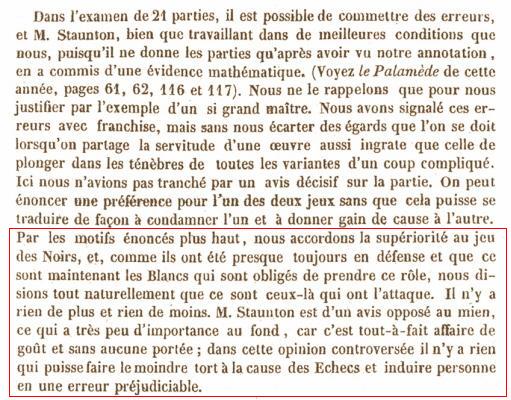
The two positions entail general positional considerations, rather than specific analysis, and we should like to know how a modern master assesses the respective views of Saint-Amant and Staunton.
The game, which Saint-Amant won at move 58, lasted nine hours (Le Palamède, February 1844, page 66).
(5709)
Regarding the annotational disagreement between Staunton and Saint-Amant arising from the 16th game of their match in Paris in 1843, the first diagram below shows the position after 19...Na7-b5. Play continued 20 exf5 gxf5 21 Nh5 Qe8 22 Nxf6+ Rxf6 23 fxe5 Qxe5, reaching the second diagram.


Yasser Seirawan (Amsterdam) writes:
‘After 19...Nb5 I much prefer Black’s position. I consider Staunton’s move 20 exf5 to be dubious because, as Saint-Amant correctly points out, the d5-pawn becomes weak. After 21 Nh5 I would have played 21...Bh8, retaining the two bishops and raising the question of what the white knight is actually doing on h5.
Regarding the second position, I am not sure that Black stands better any more, and he may have frittered away his advantage at this point by failing to keep his two bishops. So is Saint-Amant’s claim that Black has the attack true? After 24 Bb2 Nd4 (if 24...Qe3+ 25 Kh1 Rf7 26 Rf3 and 27 Nf4, I do not see Black’s “attack” at all) 25 Bxd4 cxd4 26 Nf4, and White’s problems are over.’
(5715)
Further to the Tarrasch-Lasker story (C.N. 5707), we note the following variation on a theme: a passage by Saint-Amant in the course of his bitter public dispute with Staunton. It comes from page 40 of Le Palamède, January 1845:
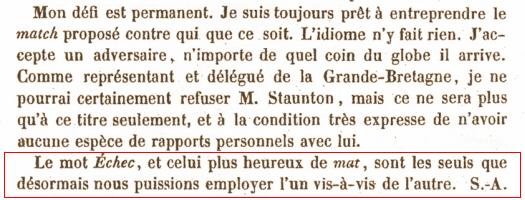
(5719)
From page 10 of Chess Pieces by N. Knight (London, 1949):

From page 144 of Caissa’s Web by Graeme Harwood (London, 1975):

The passage comes from the first paragraph of an article on pages 189-191 of the 1852 volume of the Chess Player’s Chronicle, but the magazine stated, on page 191, that the article was taken from the West of England Conservative Journal. What grounds could there be for ascribing the text to Staunton?
(6055)
Alan O’Brien (Mitcham, England) notes the curious discrepancies futile/fertile and variety/vanity in the versions reproduced by N. Knight and G. Harwood. It is the latter who went awry. Below is the passage from the West of England Conservative Journal as it appeared on page 189 of the 1852 Chess Player’s Chronicle:

(6061)
Dan Quigley (Augusta, GA, USA) asks about an encounter involving Löwenthal and Staunton (London, 1856) which may be found listed in databases as a consultation game:
1 e4 e5 2 Nc3 Nf6 3 f4 d5 4 fxe5 Nxe4 5 Nf3 Bg4 6 Be2 Nc6 7 Bb5 Bb4 8 Qe2 Ng5 9 Qf2 Bxf3 10 gxf3 O-O 11 Bxc6 bxc6 12 Ne2 f6 13 h4 Ne6 14 c3 Ba5 15 d4 fxe5 16 dxe5 d4 17 Bd2 Qd5 18 Rf1 Bb6 19 Qg3 d3 20 Nc1 Rad8 21 Nb3
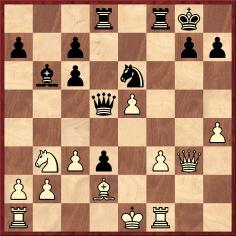
21...a5 22 c4 Qxc4 23 Bc3 Bd4 24 Nxd4 Nxd4 25 Kd2 Ne6 26 f4 Nc5 27 Rae1 Ne4+ 28 Rxe4 Qxe4 29 Rf2 Rf7 30 Qe3 Qf5 0-1.
Our correspondent also mentions a database where 21...a6, and not ...a5, is given.
We note that the game was published on pages 28-29 of the 1859 Chess Player’s Chronicle:
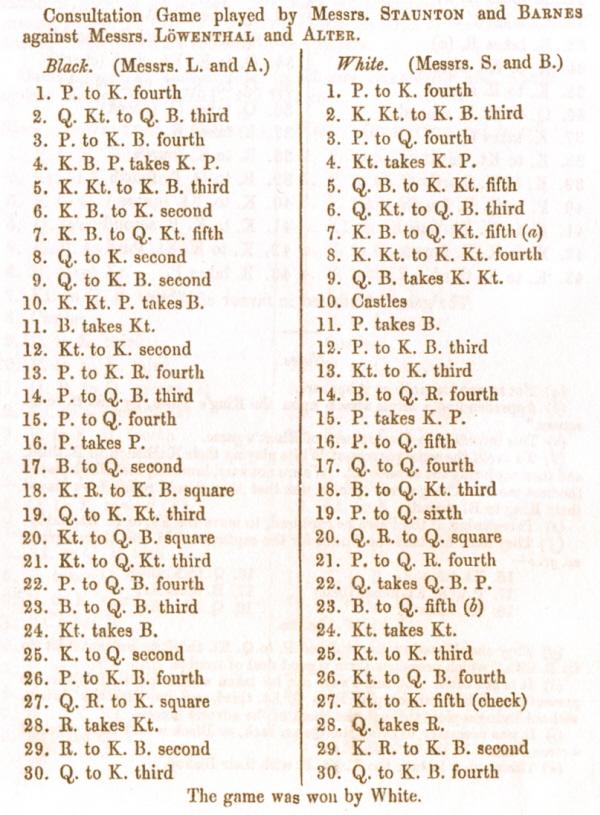

Löwenthal’s partner (‘Alter’) was John Owen.
Another consultation game (Löwenthal and Barnes v Staunton and Alter) was on pages 26-28 of the Chronicle, with this introduction on page 26:
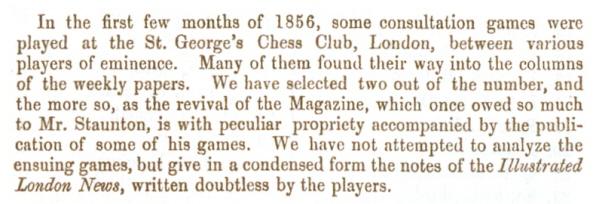
With regard to the Illustrated London News, Rod Edwards (Victoria, BC, Canada) kindly informs us that the game under discussion was in Staunton’s column on page 258 of the 8 March 1856 issue (with 21...a5). Mr Edwards adds:
‘After Staunton and Barnes’ 30...Qf5, Staunton stated in the Illustrated London News that “The remaining moves were not recorded, but the game was won by White”. It should be borne in mind that Staunton and Barnes had the white pieces.
It was one of a series of consultation games played between Staunton and Löwenthal in which each player had various allies. Sometimes the allies even switched partners. The series was announced on page 187 of the 16 February 1856 Illustrated London News, where the result of the first two games was given. Cumulative scores were provided periodically, and the last tally that I have found was in the 13 September 1856 magazine (page 281): “Staunton and Co.” had nine wins and “Löwenthal and Co.” five, with two games drawn. However, consultation games between Staunton and Löwenthal with various allies continued to be reported sporadically until the 4 July 1857 issue (page 22).’
(6455)
Rod Edwards writes:
‘The record of Howard Staunton’s matches given on pages 129-130 of your 1981 book World Chess Champions shows the result of his match with Charles Henry Stanley at the odds of pawn and two moves as +2 –3 =1, and the year is given as 1841. The Oxford Companion to Chess (first edition, page 324; second edition, page 389) concurs on the result and the year. Feenstra Kuiper’s Hundert Jahre Schachzweikämpfe (page 12), Golombek’s Encyclopedia (pages 307 and 456 of the hardback and paperback editions respectively) and Chess Results, 1747-1900 by Di Felice (page 3) all have the same result but give the year as 1839. Fiske’s New York, 1857 tournament book (page 406) states that the match was played not long before Stanley’s departure for the United States (which he says was in 1842), and that Stanley won “by a large majority”.
However, in the 1842 volume of the Chess Player’s Chronicle (page 368) Staunton wrote:
“Messrs St--n and S--y have played in all but 12 games, exclusive of drawn ones, at the odds of ‘the pawn and two moves’. Of these 12, Mr S--y won seven, and Mr St--n five.”
I wonder where the +2 –3 =1 result comes from originally, and how it can be reconciled with Staunton’s claim in the Chess Player’s Chronicle.
World Chess Champions indicates (page 130) that in cases where the final scores were not known the match results given “are those of surviving games”. Presumably, this does not apply to the Staunton-Stanley match, since I count eight game-scores in volume two of the Chess Player’s Chronicle (pages 117-118, 200, 211-212, 213, 226-228, 241-242, 293-294 and 324-325), amounting to +3 –4 =1 for Staunton. I wonder whether all these games were considered part of the formal match.’
The Staunton biography and results tables in World Chess Champions were by R.N. Coles. The only addition that we can offer at present is that an account of Stanley’s life on pages 364-367 of the August 1982 BCM (following research by Jeremy Gaige) stated that Staunton was defeated +2 –3 =1 and that the contest took place in December 1841.
(6563)
Mario Ziegler (Nonnweiler, Germany) refers to the fifth game in the Staunton v Horwitz encounter at the London, 1851 tournament. Page 84 of Staunton’s tournament book gave the moves 35 Rc2 Ng8 and then stated:
‘Owing to an unfortunate miscarriage, the MS of the remaining portion of this game, by far the best part, was lost. The game was won by Staunton.’
Our correspondent asks, firstly, whether the missing moves are available anywhere.
Secondly, he points out that if Staunton did indeed win that game his total score in the match against Horwitz would be +5 –2 =0, since all seven games (pages 71-88) were indicated as having a decisive outcome. However, page 38 stated:
‘In this section the victory in each contest was adjudged to the player who first won four games.’
Moreover, page 174 gave the final score between Staunton and Horwitz as +4 –2 =1. The question, therefore, is which of the seven games was drawn.
We note that page 219 of the 1851 Chess Player’s Chronicle stated that it was the fourth match-game, but can that be so? The tournament book (page 82) shows that game as finishing with an overwhelming advantage for Staunton (after his final move 33...b2):
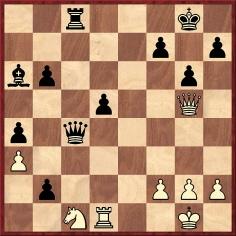
Restrictions were initially placed on the dissemination of games from London, 1851, as shown by the first quotation in Copyright on Chess Games.
(6598)
C.N. 6598 quoted the concluding note on page 84 of Staunton’s book on the London, 1851 tournament, concerning his fifth match-game against Horwitz:
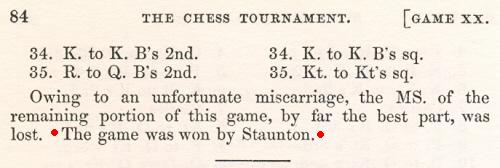
Michael Clapham (Ipswich, England) points out that in a subsequent edition of the tournament book (published by Bell & Daldy, London in 1873) the text was amended to state that the result was a draw:
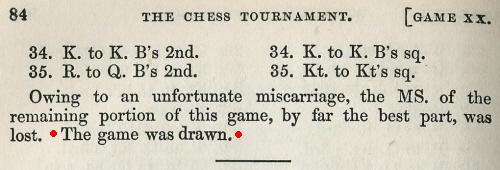
Below is the title page of the 1873 edition:
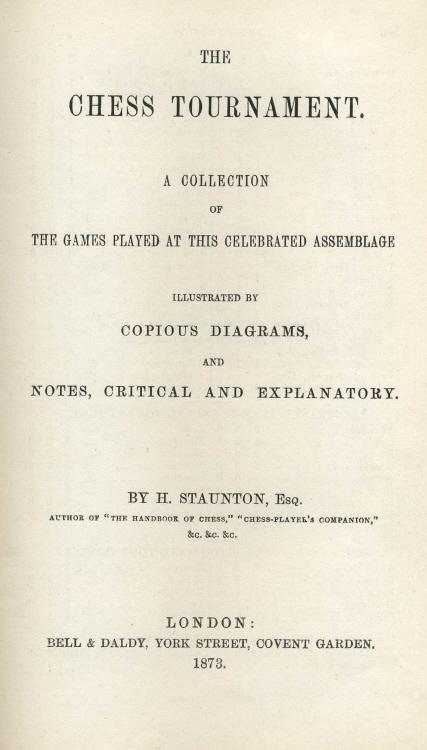
(6601)
A number of comments on Hoyle by Staunton in the Illustrated London News are drawn to our attention by Jon Crumiller:
(6790)
The book also contains carefully-researched material about some secondary figures discussed in C.N., such as T. Beeby, F.M. Edge and J. Worrell.
(7038)
Further to the item (C.N. 7277) about Bernhard Horwitz’s application for support from the Royal Literary Fund, John Townsend writes:
‘It seems that Clement Mansfield Ingleby, a Shakespeare critic and chessplayer, had some influence in such matters. He held a position at the Royal Society of Literature, 4 St Martin’s Place, and he wrote to the Prime Minister, Disraeli, immediately after Staunton’s death, seeking a pension on the Civil List for Staunton’s widow. (See page 167 of my recent book Notes on the life of Howard Staunton.)
One way of dealing with such requests was via a grant from the Royal Bounty, which was one of the classes of the Civil List, being at that time under the administration of the Prime Minister. In Mrs Staunton’s case, a lump sum of £200 was granted. (See Records of the Royal Bounty (1868-1880), National Archives, PMG 27/62, page 136 (1874).) If Horwitz’s application followed a similar course, one might hope to find an entry during 1872 or 1873 in the same group of records at the National Archives.’
(7287)
An article by G.H. Diggle published in the March 1980 Newsflash and reprinted on page 55 of Chess Characters (Geneva, 1984):
‘In the February Newsflash the Editor refers to the Olympic controversy and invites general comment on “politics and sport” with special reference to chess. The Badmaster, far too timorous and cagey a bird to accept such a gambit as this, will confine himself to recounting what actually took place when a boycott of a famous international chess tournament was attempted 130 years ago. In 1851 England, as the greatest nation in the world, staged the Great Exhibition, and Howard Staunton, as the greatest chessplayer in the world, proposed that England should be host country of the First International Chess Tourney. The conception of this idea was magnificent, and its execution by Staunton a tremendous feat, when travel was still so slow and inter-communication so poor. Yet the success of the tournament was jeopardized not only by these difficulties but by a boycott which, however, emanated not from outside countries’ dislike of Britain but from dislike in certain quarters of Staunton himself. For the great man, splendid chess leader as he was, possessed every quality except tact. His aggressive and overbearing personality had put him at variance with the wealthy and powerful London Chess Club. He himself was confidently expected to win the tournament, if it came off; and (as is now said of the Soviet Union) it was said by his enemies that his real object in organizing the event was to puff himself. Consequently, “the London” would have nothing to do with it; Harrwitz (their professional) did not compete; and out of the much-needed £550 raised in subscriptions by Staunton’s efforts, only two of their members subscribed (John Cochrane then in India and their venerable honorary member William Lewis). In the end seven foreign masters arrived and competed with nine Englishmen not all of their calibre, especially “Mr Mucklow, a player from the country never before even heard of” – his very name, indeed, suggesting a rustic crewyard. Before their boycott, the London Chess Club had toyed with the idea of getting the venue changed from the St George’s Club to their own; and after the tournament (in spite of the boycott) had run to its conclusion on 21 July 1851 they hastily arranged a rival tournament at their own club for foreign masters only, to which they invited Anderssen, Deacon, Harrwitz, Horwitz, Kieseritzky, Ehrmann, Meierhofer, Löwe and Szabo. Each player had to play one game with every other (the very first “American” tournament) but, rather stupidly, the Club offered one prize only (a gold cup valued at 100 guineas). This left no inducement to players who did badly at first to go on playing. Harrwitz, indeed, took flight after losing one game; Kieseritzky had already left London for Paris whither his invitation followed him; but when the luckless French master recrossed the Channel and again reached London, half the players had packed in and he only got three games, losing to Anderssen and Meierhofer and beating Szabo. Only about 20 games were played in all, and Anderssen alone played his full quota, winning the cup with a score of 8-0-1. To sum up, the boycott damaged but did not ruin Staunton’s tournament, and the rival tournament was a shambles. Will history repeat itself in 1980?’
(7705)
What is the fairest brief description of Howard Staunton’s organizational involvement in the London, 1851 tournament?We put the matter to John Townsend, who responds:
‘“Played a leading role in” would be my choice.
However, there were limits to his involvement and responsibility. The Committee included several aristocrats, who could be infinitely more powerful than he was.
Rivalry existed between the London Chess Club and the St George’s and, where there was conflict, Staunton has been blamed. However, his was only one voice on the Committee – albeit an important one – so he was not solely responsible for decisions taken. Neither was Staunton the Secretary of the Committee. That was Miles Gerald Keon, and it was he who dealt with correspondence on behalf of the Committee.’
(11870)
This article by G.H. Diggle, originally published in Newsflash, April 1981, was given on page 67 of Chess Characters (Geneva, 1984):
‘Chess matches have often been abandoned half-way through by demoralized combatants after successive wins have been piled up against them; Harrwitz v Morphy and Kostić v Capablanca are notable examples. Dr Hübner’s recent resignation to Korchnoi is a more unusual case, as he was only potentially 4-6 down with six games to play. In 1851, however, there were two similar match resignations caused (as in Hübner’s case) by stress, though in both cases the stress was not due so much to “world publicity” as to the “intolerable tedium” of pre-time-limit chess. In one of these Staunton, with a level score against Williams, resigned the match (after the 13th game had proceeded for 20 hours) “rather than undergo the torture of another game”. The other case (though recounted in the BCM for February 1940) is less well-known. In one of the “side-shows” of the great 1851 tournament, the youthful Frederic Deacon, burning with eagerness to win his chess spurs, was, though already notorious for slow play, selected very injudiciously by the Committee to play a match of seven games up with Edward Löwe, then a perfunctory old stager nearly 40 years Deacon’s senior. The prizes were £8 to the winner and £3 to the loser, and Deacon won the first two games, with Löwe moaning throughout about Deacon’s slowness. In the third game (Deacon later wrote to the Tournament Committee) “Mr Löwe noted the time I took to consider a move and then delayed double that time before he made his own – this was in the presence of Mr Löwenthal and Mr Williams.” (The BCM comments, “We can imagine Williams scenting tedium and watching this new experiment with the air of a patron.”) Deacon’s attempt to speed things up led to his losing the game in 37 moves after a mere four and a half hours’ play. Finally in the fourth game, as Deacon was considering his 16th move after about two and a half hours’ play “when I had unquestionably the better game” Löwe suddenly resigned the match and walked off. To all arguments to induce him to resume the contest Löwe replied that he found there was no time to fulfil his business engagements if he had to play any more chess with Deacon, to whom he resigned the prize. “I cannot say fairer!” This left Deacon with no other course but to write to Staunton as Secretary of the Tournament troubling the Committee for “the prize which I of course believed to be my due”. Then came the unkindest cut of all. “The Committee were not prepared to award any prize as the conditions of the match had not been fulfilled.” Deacon pointed out with indignant triumph that if this ruling became “case-law” it would always be in the power of one player to prevent his antagonist receiving the prize by resigning the match “even just before he had lost his seventh game”. This so staggered the Committee that they brought pressure to bear on Löwe, who was finally induced to play out the match, Deacon winning 7-2-1. Staunton in annotating the games admits that “the tedium of Mr Deacon’s play is quite insufferable, and although with him this arises from habit only, and not from a design to exhaust and irritate an opponent, the sooner he corrects so grave a fault the better.”’
According to Jeremy Gaige’s Chess Personalia (Jefferson, 1987), Frederic H. Deacon was born in Bruges in about 1829 and died, possibly in Brussels, circa October 1875. However, the privately-circulated 1994 edition gave his full name as Frederick Horace Deacon and stated that he was born in Bruges in about 1830 and died in Brixton, London on 20 November 1875. The additional sources specified by Gaige were the death certificate (reporting that Deacon died at the age of 45) and the probate record.
(7854)
From John Townsend:
‘In C.N. 7854 G.H. Diggle reported:
“In one of these Staunton, with a level score against Williams, resigned the match (after the 13th game had proceeded for 20 hours) ‘rather than undergo the torture of another game’.”
Although the match score was level, the same cannot be said of the position on the board, since, at the time of his resignation, Staunton was a piece down in a completely lost endgame. On page 349 of The Chess Tournament (London, 1852) he made a curious remark in a note to his move 41...Kf7 in that game.
“It is clear that Black could have made a drawn battle if he chose, by
41...R to KR’s 8th
42 K to Kt’s 2nd, or 3rd 42 R to QKt’s 8th
43 B to QKt’s 2nd 43 K to B’s 2nd, etc.but it having been long quite evident that his opponent would protract the sitting until he (Black) could no longer support the fatigue (the present game lasted above 20 hours!), he preferred resigning the contest, although two games ahead, to undergoing the torture of another game.”
What exactly did Staunton mean by the last part of that remark? If he was suggesting that his inferior choice of 41...Kf7 was his way of capitulating, he omitted to explain why he played on for a further 38 moves. His eventual resignation, at move 79, was fully called for. He was, clearly, frustrated by Williams’ slow play, but here he seems to have confused that issue with the subject of his resignation and, hence, to have picked the wrong battlefield on which to attack Williams.
This was the return match after Williams had defeated him in the play-off for third place in the tournament. It was played at Staunton’s “country house” in Cheshunt, the exact location of which is not known. As he led by six wins to three before the 13th game but had given Williams the odds of three games’ start, the Badmaster was correct that the match score stood level. Staunton’s remark quoted above that he was two games ahead must be wrong, unless he meant that, after losing the 13th game, he remained two games ahead. Being two games ahead was useless, since Williams, by scoring his fourth win in the 13th game, reached the target of seven wins needed to secure the match, so for Staunton “undergoing the torture of another game” was no longer an option.’
(7858)
James Pelletier (Costa Mesa, CA, USA) refers to game 13 in the 1843 match in Paris between Saint-Amant and Staunton, which is commonly given in databases as follows:
1 d4 e6 2 c4 d5 3 e3 Nf6 4 Nc3 c5 5 Nf3 Nc6 6 a3 Be7 7 Bd3 O-O 8 O-O b6 9 b3 Bb7 10 cxd5 exd5 11 Bb2 cxd4 12 exd4 Bd6 13 Re1
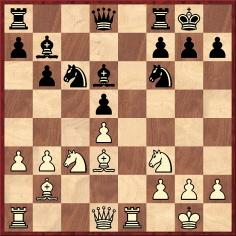
13...a6 14 Rc1 Rc8 15 Rc2 Rc7 16 Rce2 Qc8 17 h3 Nd8 18 Qd2 b5 19 b4 Ne6 20 Bf5 Ne4 21 Nxe4 dxe4 22 d5 exf3 23 Rxe6 Qd8 24 Bf6 gxf6 25 Rxd6 Kg7 26 Rxd8 Rxd8 27 Be4 fxg2 28 Qf4 Rc4 29 Qg4+ Kf8 30 Qh5 Ke7 31 d6+ Kxd6 32 Bxb7 Kc7 33 Bxa6 Rc3 34 Qxb5 Resigns.
However, on pages 65-67 of the Chess Player’s Chronicle, 1844 (volume five) and on pages 350-351 of Staunton’s book The Chess-Player’s Companion (London, 1849) the score was given as 13...h6 14 Rc1 Rc8 15 Rc2 Rc7 16 Rce2 Qc8 17 h3 Nd8 18 Qd2 a6. That would allow Saint-Amant to play Nb5 on or before move 18, and Mr Pelletier therefore wonders whether the actual move-order was 13...a6 and 18...h6.
We recall that the matter was discussed in the BCM after publication of Championship Chess by P.W. Sergeant (London, 1938). Below is page 205 of the May 1938 BCM:
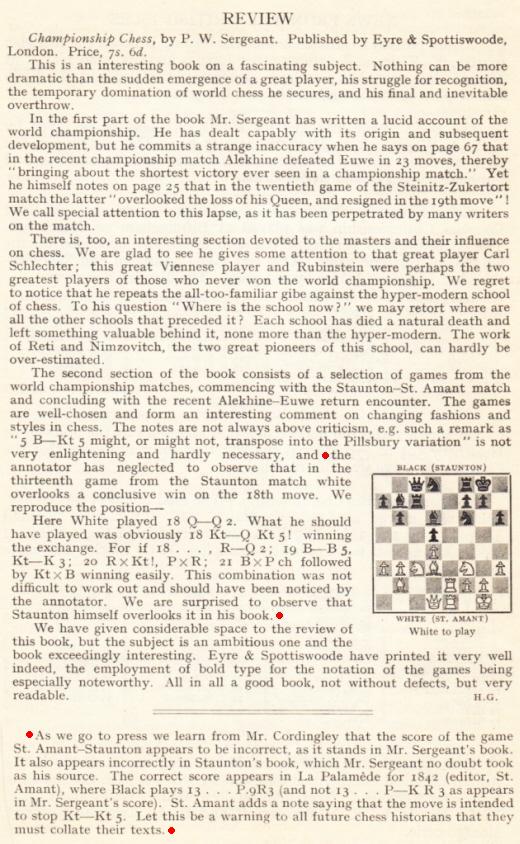
A response to Golombek’s review from G.H. Diggle was published on page 405 of the September 1938 BCM:
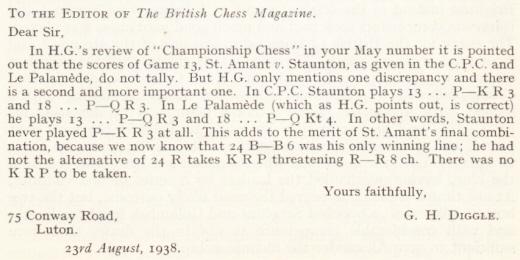
We reproduce below the score as given on pages 23-24 of the January 1844 issue of Le Palamède:
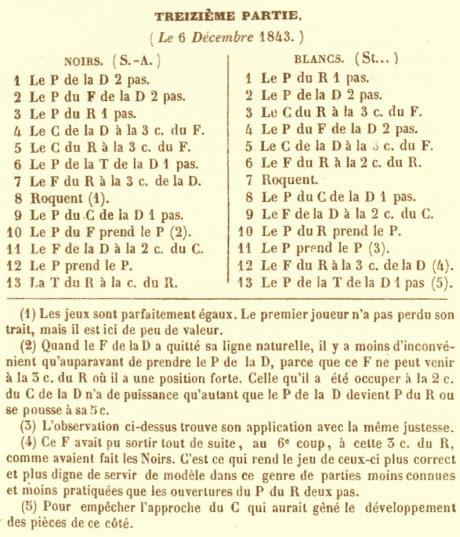
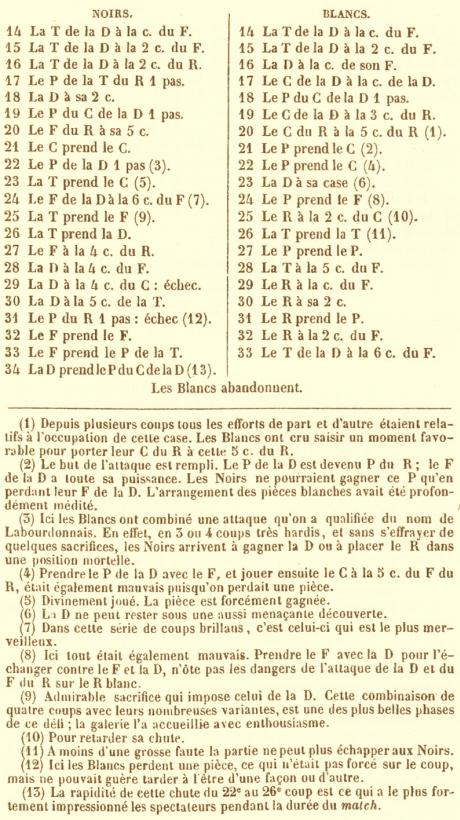
In short, there is every reason to believe that the game-score in Le Palamède is correct. If ...h6 had occurred at some point and ...b5 had not been played, Saint-Amant would have had 33 Qxf7+ instead of 33 Bxa6, since the rook on c4 would be en prise.
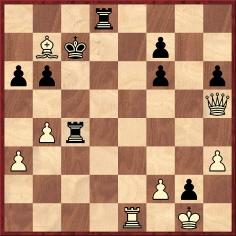
(8055)
From pages 88-89 of the Westminster Papers, 1 September 1874:

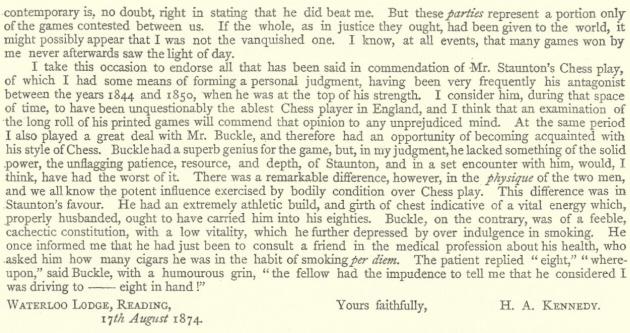
(8348)
‘Years ago, when the game in this country [England] was of a thoroughly national type, we could boast of an independent school of players, represented by Lewis, McDonnell, Staunton, Cochrane and Buckle, second to none in originality, in brilliance, and in power. Chess, both in theory and practice, was here in its zenith; the game enjoyed a vitality unprecedented in the history of any other country; individual players of eminence sprang up in all directions throughout the provinces; and no fewer than 140 chess clubs were at one time in active operation. But from the time when the wholesome national feeling first degenerated into a spurious universalism, we may date the gradual decline of English chess. Player after player seceded from the arena; no new generation arose to supply their place; club after club was closed, until at the present day scarcely 40 British chess societies remain alive, and unhappily many of these exist only in name.
Let us, then, on behalf of the great and once-famous chess school of England, appeal to our countrymen to aid in arresting the progress of this lamentable decay. Let not the decline of our Empire degenerate further into a fall. We are satisfied there is in this country no lack of chess enthusiasm or intelligence, and that numerous amateurs who have hitherto stood aloof, owing to the present abnormal condition of the game in England, would gladly come to the rescue of the cause could they but find a centre for common exertion. Such a rallying point an organ exclusively devoted to the game, and edited by Englishmen, we feel assured will prove; and such a rallying point it is our ambition to provide by the establishment of the Chess World.’
The above comes from an editorial (‘London, March 1865’) on pages 1-3 of the first issue of Staunton’s magazine the Chess World, March 1865.
(9780)
A famous Staunton position, from his eighth match-game against Elijah Williams, London, 1851:
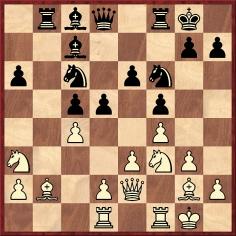
Staunton (White) played 14 Bxf6 Qxf6 15 cxd5 exd5 16 d4.
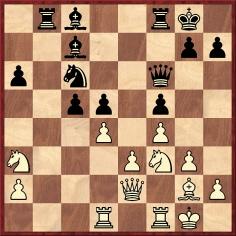
On page 155 of Better Chess (London, 1997) William Hartston wrote after 16 d4:
‘Envisaging this pawn move, White first exchanged his black-squared bishop to ensure that it would not become bad (though it was another 50 years before anyone came up with the concept of a “bad bishop”).’
When were the concept and the term ‘bad bishop’ first recorded in print?
(7769)
See too C.N.s 10844 and 11048.
A passage about FIDE’s regulation of world championship matches, on page 35 of Fischer/Spassky by Richard Roberts with Harold C. Schonberg, Al Horowitz and Samuel Reshevsky (New York, 1972):
‘About one thing there is no question: The present system is far superior to the one that permitted Howard Staunton to call himself the champion of the world although he refused to play Paul Morphy, the New Orleans-born genius who had swept through America and Europe decimating the finest players the world had to offer.’
Concerning Staunton, the opportunity is taken to request additions to Early Uses of ‘World Chess Champion’.
(8897)
Fischer’s own view of Staunton was given in the article ‘The Ten Greatest Masters in History’ (on pages 56-61 of Chessworld, January-February 1964):
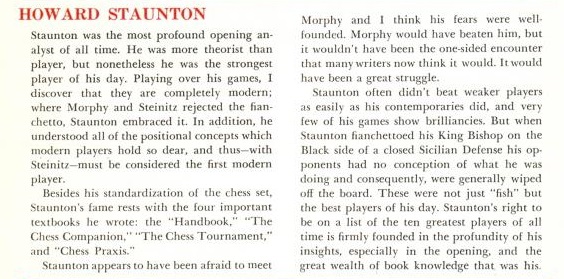
Robert John McCrary writes:
‘In his column in the Illustrated London News of 25 December 1847, page 411, Staunton answered a correspondent, “Senex”, as follows:
“There is a good deal of Chess-play, we are told, at New Orleans, although the strongest player, Mr Rousseau, is no longer a resident there ...”
No further details were provided, but this reference to New Orleans chess, as known to Staunton in England at the time, is interesting in view of the presence there of the ten-year-old Paul Morphy.’

(9392)
Hans Renette (Bierbeek, Belgium) has found on page 2 of the Standard (London), 2 April 1889 a report about an accusation of fraud against Frederick Lloyd (‘Frederick Staunton’/‘Frederick Stanton’), who claimed to be Howard Staunton’s nephew:
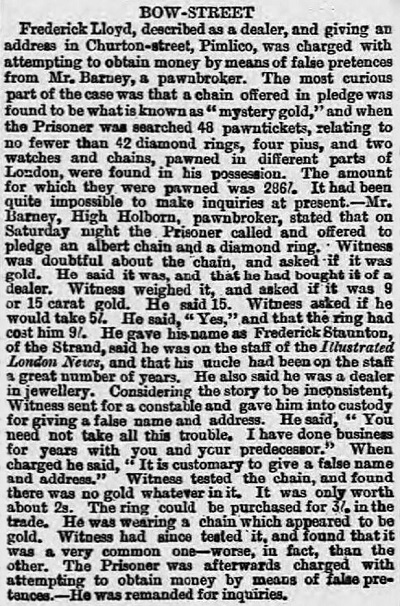
Our correspondent notes that further information is available on the website The Proceedings of the Old Bailey.
(9474)
John Townsend reports that in the London Gazette of 3 February 1891 (‘The Bankruptcy Acts, 1883 and 1890. Receiving Orders’) there was an entry under ‘Debtor’s Name’ for Frederick Charles Howard Staunton. The column headed ‘Address’ had the following:
‘Lately residing at 5 Churton-street, Pimlico, Middlesex, present place of residence the Petitioning Creditor has been unable to ascertain.’
The same street was mentioned in the news report shown in C.N. 9474.
(9496)
Even in the pre-Internet age, some people required only a few words or lines to give themselves away in terms of unfairness and/or inaccuracy. From page 10 of The Collier Quick and Easy Guide to Chess by Richard Roberts (New York, 1962):

(9869)
The Chess-Player’s Handbook by Howard Staunton (London, 1847) was widely copied, with or without acknowledgement and often without thought.
An example, concerning J’adoube, is provided by page 36, in the section entitled ‘The Laws of the Game’:

A search in Google Books shows that Staunton’s text was reproduced verbatim in a number of publications, even though the first part of Law IX is obviously faulty.
The rule in question (from ‘Laws of Chess, as lately revised by a Committee of the London Chess Club’, published on pages 266-269 of the Chess Player’s Chronicle, 1842):

In the Handbook the fourth word, ‘take’, was subsequently corrected to ‘touch’. In which edition was the amendment first made?
(10078)
From page 278 of the September 1963 BCM, in D.J. Morgan’s Quotes and Queries column:

It will be appreciated if a reader can provide the item published in Canadian Chess Chat. For now, we give an extract from a column by George Koltanowski on page 10 of the Corpus Christi Caller-Times, 20 May 1962:
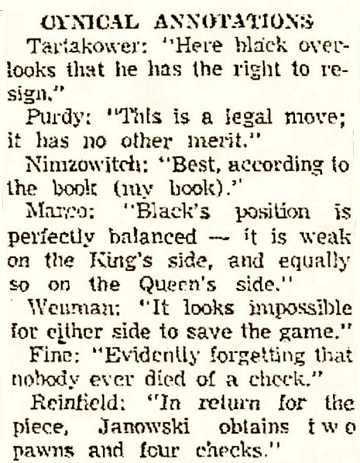
As ever, factual information about such quotations is sought. The Marco one was discussed in C.N. 5248, and the remark ascribed to Reinfeld should also mention Fine. It appeared on page 141 of the book on Lasker which they co-authored.
It is, though, the Wenman item that deserves particular attention, since it brings to mind a remark widely attributed to Staunton. For example, an article by G.H. Diggle reproduced in C.N. 7369 stated with regard to writers who annotated the 1834 Labourdonnais v McDonnell games:
‘Staunton himself, who did so (Chess Player’s Chronicle, volumes 1-3), really sums up the series in a famous note to game 21: “It seems utterly impossible for either player to save the game.”’
In an article about the Labourdonnais v McDonnell series on pages 277-281 of the July 1934 BCM Diggle wrote:
‘Some of their complications have driven annotators to despair. Staunton himself in one case can do no more than helplessly declare: “It seems utterly impossible for either player to save the game.”’
The article was reproduced on pages 69-75 of The Treasury of Chess Lore by Fred Reinfeld (New York, 1951).
Presenting game 21 on pages 94-95 of Lessons in Chess Strategy (London, 1968) W.H. Cozens wrote:
‘Staunton’s note after White’s 29th move makes an apt comment: “It now seems hardly possible for either player to save the game.”’
However, pages 83-84 of The World of Chess by Anthony Saidy and Norman Lessing (New York, 1974) had the following with regard to a different game (50):
‘Beyond inserting a number of exclamation points it is useless to try to annotate this wildly uninhibited game. Howard Staunton, the famous English player, made the attempt some years later, only to give up with the historic remark: “It seems utterly impossible for either player to save the game!”’
It took us a while to find confirmation of Staunton’s words (in connection with game 21), on page 133 of his posthumous book Chess: Theory and Practice (London, 1876). Below is the relevant page in a late edition (London, 1920, published under the title The Laws and Practice of Chess):
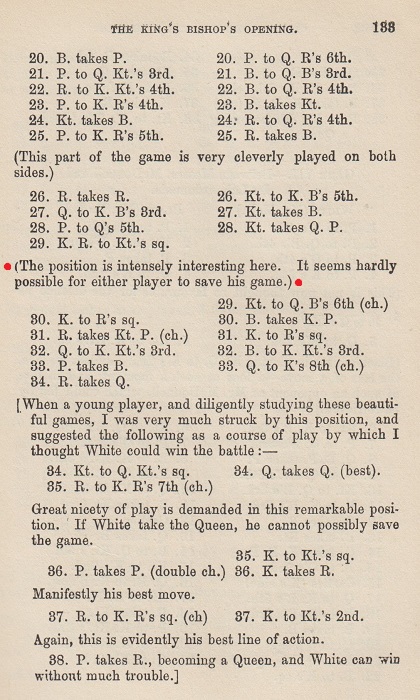
That leaves the question of why Wenman’s name was introduced for a similar remark, and we can give a citation from his book One Hundred and Seventy Five Chess Brilliancies (London, 1947):
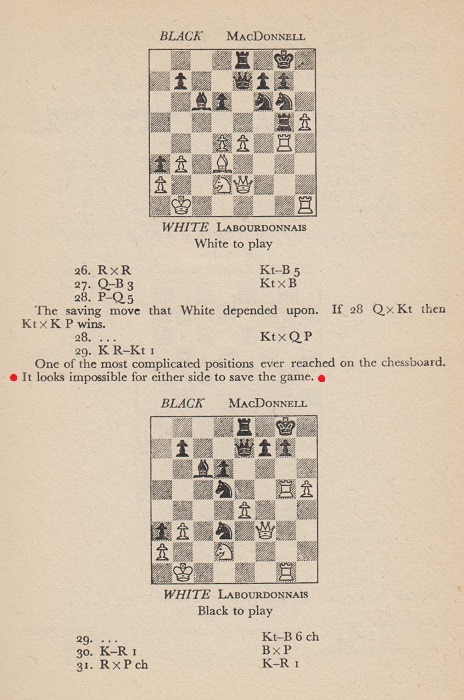
That unnumbered page is game 53 in Wenman’s book and is, of course, part of his coverage of the above-mentioned game 21 in the Labourdonnais v McDonnell series.
(10171)
John Townsend writes:
‘From Howard Staunton’s column on page 336 of the Illustrated London News, 24 May 1845:
A mirror-image of the position had appeared in Staunton’s column on page 338 of the New Court Gazette, 30 May 1840:
Mate in six cannot be achieved with the best defence by Black, viz. 1 Qf5 hxg5 2 Qxf8+ Kh7 3 Qf5+ g6 4 Re7+ Kh6 5 Qf8+ Kh5 6 Rh7+ Kg4 7 Qf3 mate.
Why did two very similar positions appear? If both accounts are to be believed, and the two problems represented a position which arose once in play, it would be the deciding game in a match at the odds of queen’s knight, played at the Westminster Chess Club before the end of 1839 (when the Club was dissolved). No such match by Staunton at those odds is on record.’
(10551)
John Townsend writes:
‘Regarding Staunton’s paternity, a novel variation on the Earl of Carlisle story was discussed briefly in an Australian newspaper. This was the Cairns Post of 11 July 1934, which carried on page 8 the following remarks under the heading “New Books”, as part of the London – Week by Week column, “From Our Special Correspondent”:
“In his book A Century of British Chess, newly published, Mr Philip Sergeant repeats the assertion that Howard Staunton, ‘the father of British chess’, was treated ungenerously by his father, the fifth Lord Carlisle.
Actually Staunton was enabled to devote himself to serious chess through Lord Carlisle’s generosity. He was the son of a housemaid at Castle Howard. His mother continued to live for many years in the neighbouring village of Coneysthorpe.”’
(10785)
John Townsend writes:
‘Page 12 of my 2014 book Historical notes on some chess players contained a quote from Löwenthal’s chess column in the Era which supported the view that the middle part of the Staunton v Harrwitz match was played in Brighton (the first and last few games having been hosted by the London Chess Club).
It is perhaps worth adding that Saint-Amant had commented on the two venues on page 456 of the 1846 volume of Le Palamède:
“Commencé à Londres, il a été terminé à Brighton.”
Staunton described this as a “misstatement” and corrected it in a reply to two correspondents on page 3 of the Illustrated London News of 26 December 1846:
“The match was not ‘finished at Brighton’. It was began [sic] and finished in London. A portion of the games were played by mutual consent in the country ...”
He stopped short of saying that the venue “in the country” was Brighton, as was later affirmed by Löwenthal.’
(10819)
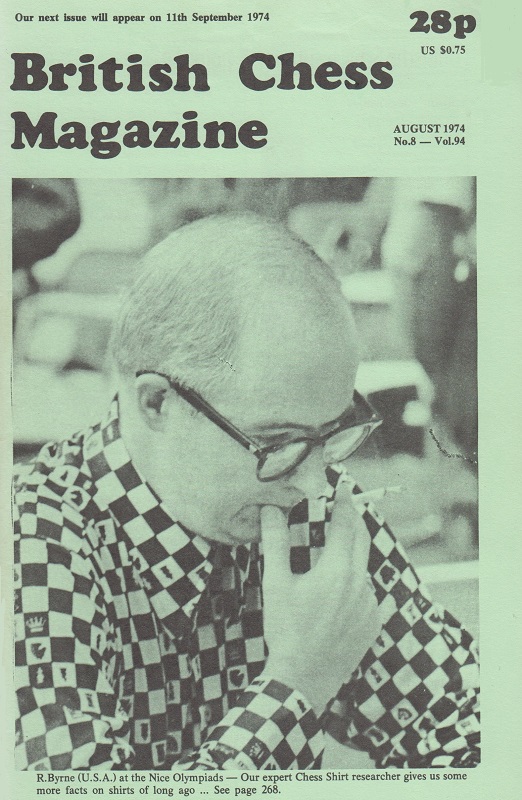
D.J. Morgan, the ‘expert Chess Shirt researcher’ mentioned in the caption, wrote on page 268:
‘F.M. Edge (a most untrustworthy writer where Staunton was concerned) states in his Morphy book that Staunton was so rabid about chess that he wore shirts with representations of the chess pieces on the breasts and tails.’
Edge’s exact words, on pages 151-152 of the New York edition of his book and page 133 of the London edition:
‘Staunton’s literary avocations now permit him but an hour or two weekly for chess, although formerly he lived in the London Divan, as Harrwitz in the Régence, and was so rabid about Caïssa that he actually wore shirts with kings, rooks, pawns, etc. printed over the bosoms and tails.’
‘It is just possible that he did’, added G.H.Diggle in D.J. Morgan’s column, pointing out these passages:

Chess Player’s Chronicle, 1847, page 68
Chess Player’s Chronicle, 1847, page 140
From page 254 of XIV. Schach-Olympiade Leipzig 1960, published by Sportverlag Berlin:
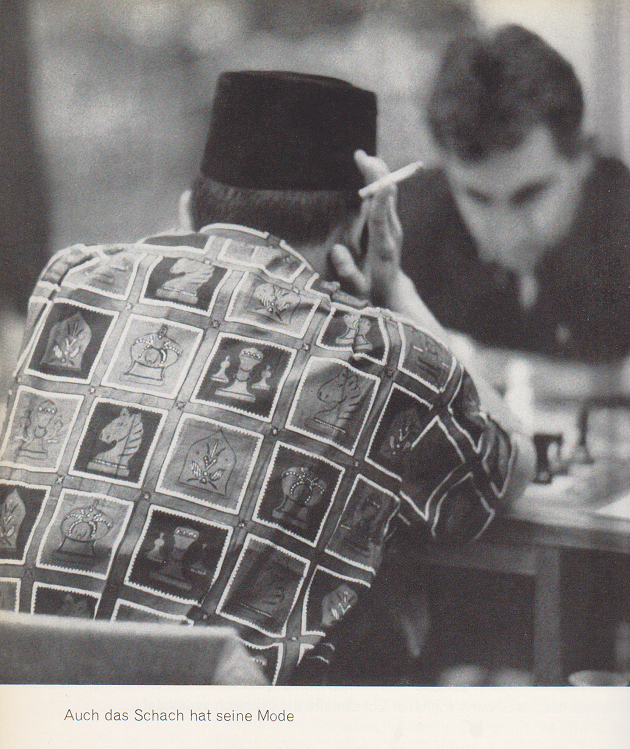
(11088)
Gerard Killoran (Ilkley, England) sends a cutting from page 15 of the Illustrated London News, 20 February 1847:
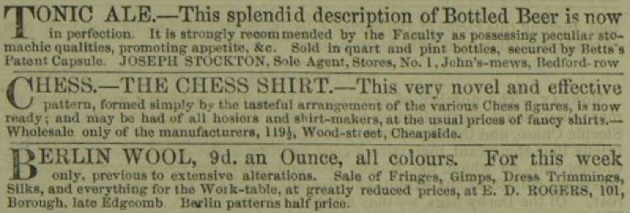
(11093)
An item on page 370 of Womanhood, November 1905:
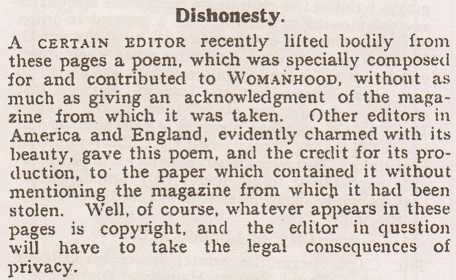
The poem in question was not identified, but the following had been published on page 130 of the April 1905 issue:
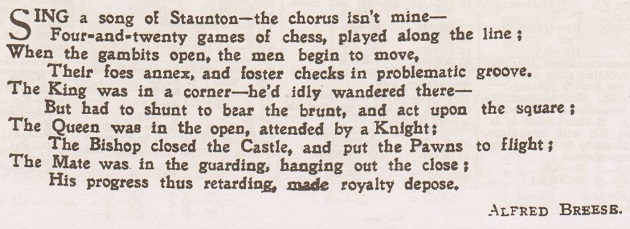
Alfred Breese’s ‘Sing a song of Staunton’ composition appeared on page 154 of Lasker’s Chess Magazine, August 1905:
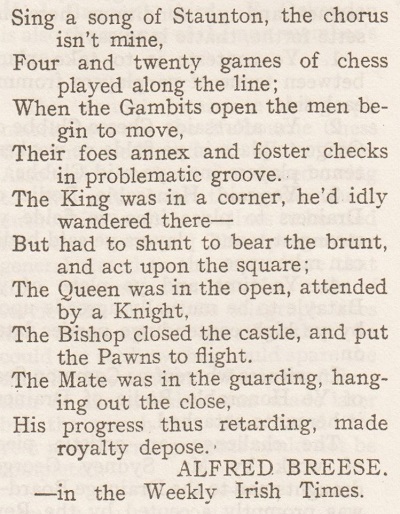
The credit to the Weekly Irish Times will be noted, but Gerard Killoran informs us that he has been unable to find the poem in any 1905 edition of that newspaper.
He has, however, come across the following, which will be added to Chess and the House of Commons:
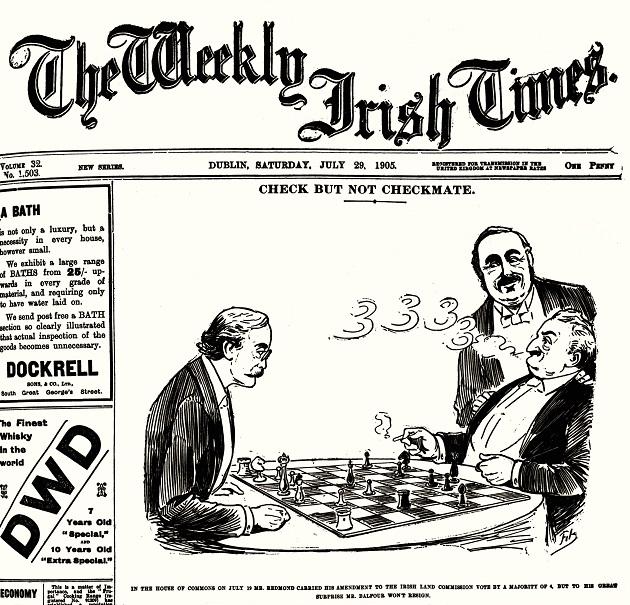
(11279)
The poem in C.N. 11279 has reminded John Townsend of the following on page 120 of the Westminster Papers, 1 December 1869:
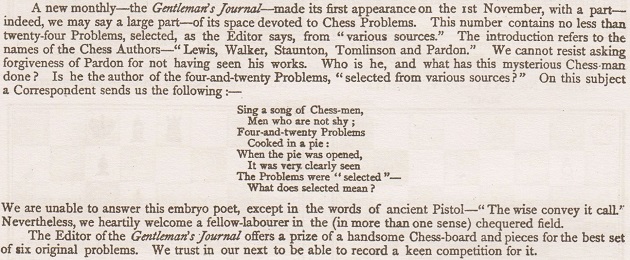
(11282)
John Townsend writes in connection with Pictures of Howard Staunton:
‘Regarding claims that Staunton’s 1843 victory over Saint-Amant in Paris was commemorated with a bronze medallion associated with St George’s Chess Club, page 157 of my 2011 book Notes on the life of Howard Staunton mentioned a life-size medallion of Staunton’s head which had been “cleverly” modelled by an Italian sculptor “some years ago”. In 1873 Staunton ordered further casts to be made and sent two of them to his fellow Shakespeare editors, James Orchard Halliwell-Phillipps and Horace Howard Furness, an American.
The following passage on pages 133-134 of C.A. Gilberg’s book on New York, 1880 has just come to my attention:
“Facing the entrance to the hall our own national emblem bore within its massive folds the name of Paul Morphy, while, vis-à-vis, a large medallion bust in alto relievo of the late Howard Staunton was appropriately surrounded with the flags of Great Britain.”
Can any further information about the Staunton medallion bust be found, and are images of any Staunton medallions known?’
We can add, courtesy of the Cleveland Public Library, the back cover of the September 1853 Chess Player’s Chronicle:
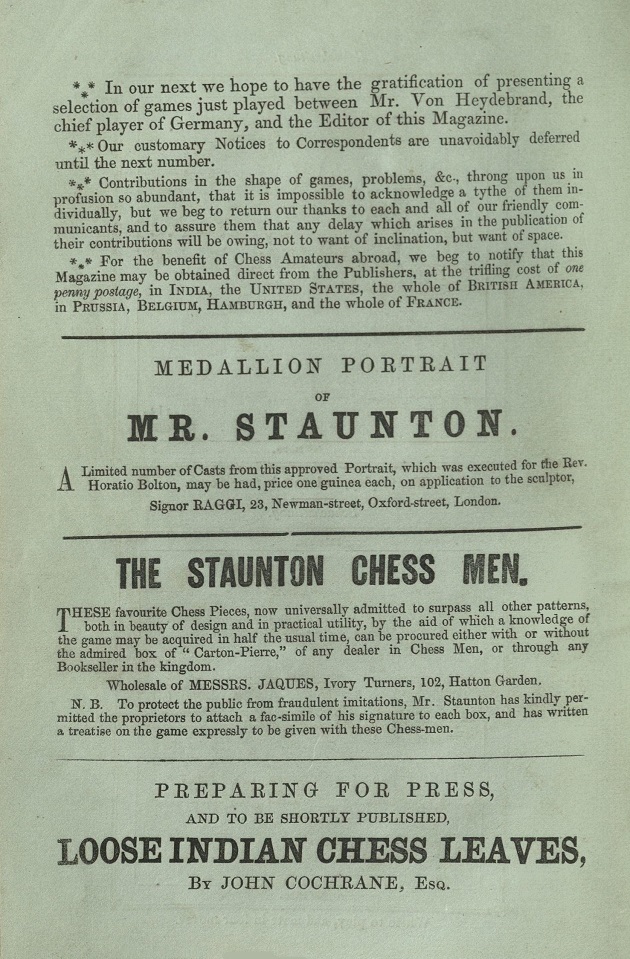
(11524)
From page 529 of the Illustrated London News, 30 May 1857:

This remark by Staunton was quoted in C.N. 91 (see page 233 of Chess Explorations). The final sentence is particularly relevant, mutatis mutandis, in the Internet era.
(11473)
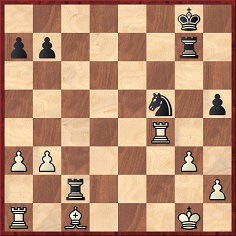
Black to move
This position was discussed briefly by Staunton when he published a consultation game against Löwenthal in the Illustrated London News column referred to in C.N. 11473 (30 May 1857, page 529):
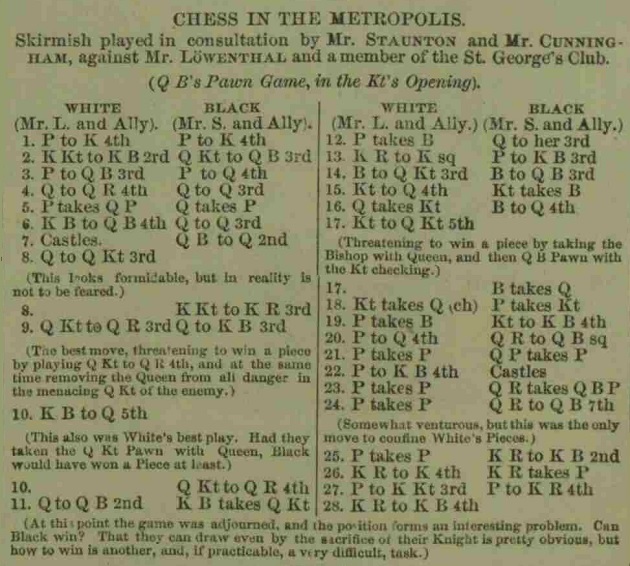
1 e4 e5 2 Nf3 Nc6 3 c3 d5 4 Qa4 Qd6 5 exd5 Qxd5 6 Bc4 Qd6 7 O-O Bd7 8 Qb3 Nh6 9 Na3 Qf6 10 Bd5 Na5 11 Qc2 Bxa3 12 bxa3 Qd6 13 Re1 f6 14 Bb3 Bc6 15 Nd4 Nxb3 16 Qxb3 Bd5 17 Nb5 Bxb3 18 Nxd6+ cxd6 19 axb3 Nf5 20 d4 Rc8 21 dxe5 dxe5 22 f4 O-O 23 fxe5 Rxc3 24 exf6 Rc2 25 fxg7 Rf7 26 Re4 Rxg7 27 g3 h5 28 Rf4.
(11477)
From John Townsend:
‘The Satirist, or Censor of the Times was a Sunday paper which specialized in scandal and innuendo. Chess was discussed occasionally, but the material needs to be viewed with great caution.
Page 4 of the 24 December 1843 issue carried the following reply to a correspondent, “Queer Gambit”, who, it is implied, had suspected some kind of skulduggery in the Staunton v Saint-Amant match in Paris:
“Queer Gambit. – Ever since chess became a betting game, it is as little removed from ‘the cross system’, as the race, the ring, the river, or running matches. We believe the contest in the French capital to have been a fair one, notwithstanding what ‘Queer Gambit’ has heard.”
The “cross system” refers to a method of breeding racehorses in which strict pedigree requirements are watered down.
Howard Staunton may have been paying the price of newly-won fame, since, two weeks later, on 7 January 1844, he was featured again, on page 4:
“A correspondent asks us if it is true that the English champion at chess, Mr Staunton, used to be known in certain circles some years back by the jocular soubriquet of ‘the Bird’. Perhaps somebody will satisfy this curious gentleman.”
No follow-up insertions have been found. Enlightenment is sought as to the possible significance of the soubriquet “the Bird”, and what the “certain circles” may have been.
The Editor was Barnard Gregory (1796-1852), who was also the leader of a company of amateur actors called the Shaksperians. According to Frederic Boase’s Modern English Biography (volume 1, pages 1233-1234):
“... he libelled and blackmailed many persons, especially Charles, Duke of Brunswick and Lüneburg.”
The Duke played against Paul Morphy in the celebrated consultation game (Paris, 1858). The same source mentions that Gregory was twice imprisoned and that he played Hamlet at Covent Garden on 13 February 1843, “when there was a riot headed by the Duke of Brunswick”.
Gregory also edited The Penny Satirist, 1837-46.’
(11568)
C.N. 1157 (see page 95 of Chess Explorations) quoted this passage from page 360 of the August 1926 BCM:
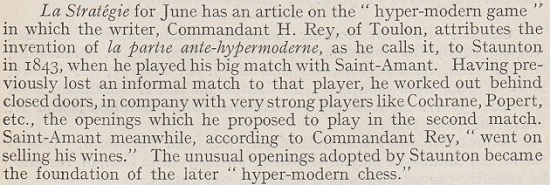
John Townsend queries the statement that Staunton, after losing an informal match to Saint-Amant, ‘worked out behind closed doors, in company with very strong players like Cochrane, Popert, etc., the openings which he proposed to play in the second match’:
‘There is strong evidence that both Cochrane and Popert were abroad during the period in question. Preparation “behind closed doors” is claimed to have taken place between the two Staunton v Saint-Amant matches, i.e. between May and November 1843. However, page 2 of Bell’s Life in London, 11 September 1842 noted that Popert had already left England for his native Germany, “where, we believe, he intends remaining two or three years, in consequence of ill health”:
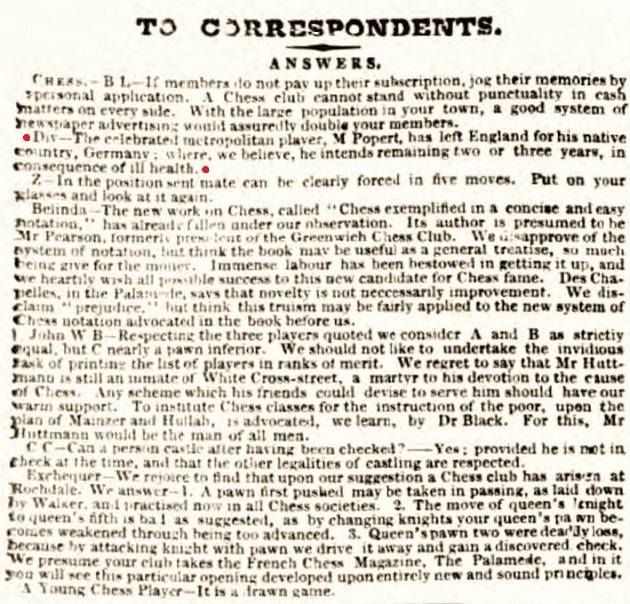
John Cochrane’s departure for India was also reported some time before the first match, in the Chess Player’s Chronicle, 1844, page 127.’
Pages 49-53 of the March 1926 edition of La Stratégie had a translation by A. Goetz of an article by Carlo Salvioli about hypermodern chess from pages 25-29 of L’Italia Scacchistica, February 1926. As shown below, the follow-up article (La Stratégie, June 1926, pages 121-122), consisted of a response submitted by Commandant H. Rey to the Marseilles newspaper Le Soleil, where the Salvioli article had also appeared in translation:
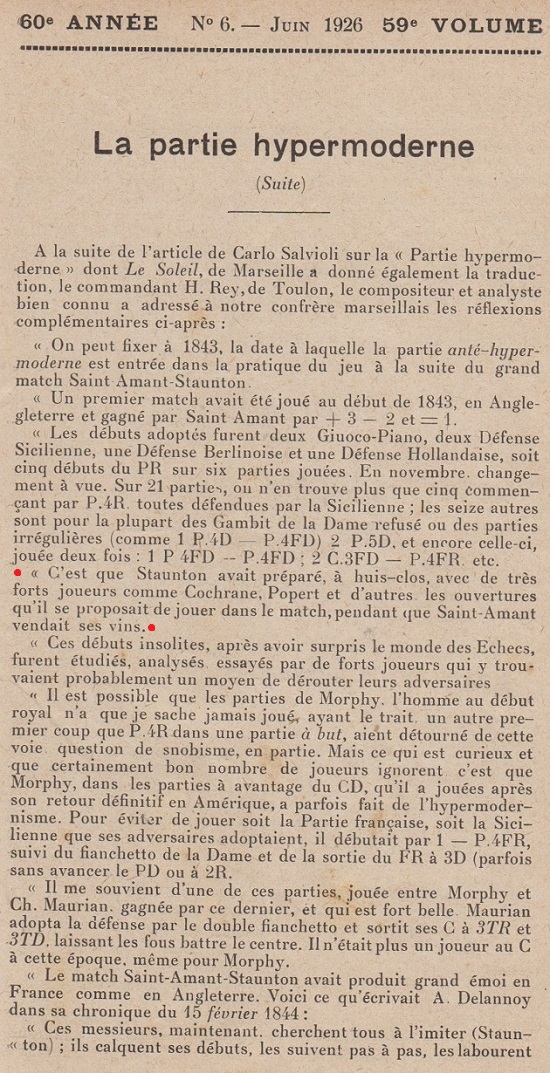
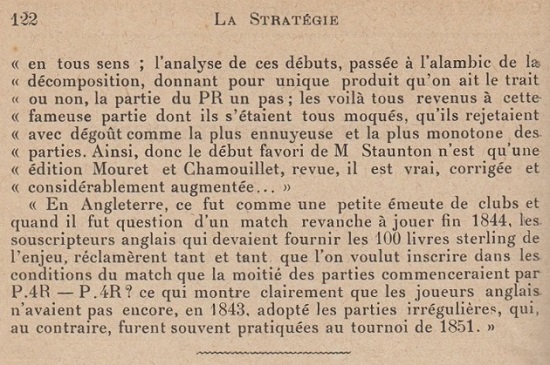
(11729)
See too Hypermodern Chess, which includes the following:An observation by W. Wayte on pages 476-477 of the December 1889 BCM:
‘Staunton, perhaps, did not begin the “struggle for position” quite soon enough in his openings, relying rather on combination in the middle game; yet with his eminent grasp of the board as a whole he is at least the forerunner of the modern school.’
(2461)
Jerry Spinrad (Nashville, TN, USA) sends, on the topic of Street Names with Chess Connections, a lengthy report on page 5 of Lloyd’s Weekly London Newspaper, 21 December 1856 which suggested, ten lines from the bottom of the second column, that a London street be named after Howard Staunton.
London does indeed have a Staunton Street, but since when?
(11810)
From John Townsend:
‘Although the pattern of Staunton chessmen was registered officially in the name of Nathaniel Cooke in 1849, it has been questioned whether he was also the designer. He is not otherwise associated with either chess or artistic design, save to say that his daughter, Harriet Ingram Cooke, seems to have been the author of The ABC of Chess, By a Lady, first published by John Jaques in 1860.
A short article in The Spectator, 17 November 1849, page 1087, entitled “The ‘Staunton’ Chess-men”, took the unusual step of naming the designer. These were the concluding words:
“The carton-pierre chest, in which the men are deposited, and which is decorated with mediaeval arches and turrets, embossed with the insignia of the game, does just credit to Mr L.S. Williams, the artist; who has also, we believe, designed the very solid and elegant pieces.”
In fact, “Mr L.S. Williams” was incorrect, and it is clear from a reply to a correspondent, “Florence”, in the Illustrated London News of the same date (page 11) that the artist being referred to was “Mr Joseph L. Williams”:
“The very beautiful and appropriate box of Carton Pierre, in which the new Chess-men are inclosed, is by Mr Joseph L. Williams, the well-known decorative artist.”
Joseph Lionel Williams (1815-77), born in Colchester, Essex, was a wood engraver, draughtsman and watercolourist. He did much illustrative work for the Illustrated London News, as did his brother, Alfred Williams.
Great caution is required before crediting Joseph Lionel Williams with the design of the Staunton chessmen, although, in view of the article in The Spectator, it seems at least possible that he designed the men as well as the box.’
(11934)
An addition from John Townsend dated 26 August 2023 and entitled ‘Staunton’s tenancy in Dulwich’:
‘Staunton’s home in Dulwich from 1865 was Ivy Cottage (also referred to sometimes as Ivy Lodge). The building no longer exists, but it lay close to the present day junction of Dulwich Village and East Dulwich Grove (as was noted in my book, Notes on the life of Howard Staunton, page 141). He was a tenant of Mrs Sarah Watson, a widow, who, in turn, was a lessee of Dulwich College.
On page 149 of Jan Piggott’s book, Dulwich College, A History, 1616-2008, it was suggested that Staunton was a “difficult tenant” and “particularly provoking”:
“The Governors were still preoccupied with the petty details of innumerable leases, squabbles between neighbours about overhanging branches, and with difficult tenants, among which Howard Staunton (1810-1874), the chess authority and Shakespearean scholar, seems to have been particularly provoking.”
I am grateful to the Keeper of the Archives of Dulwich College and to Jan Piggott for drawing my attention to the Governors’ Minutes for 1 October 1868 (pages 32-33), which contain the following account of Staunton’s assertive conduct in the matter of his tenancy:
“8. The Surveyor reports that, as instructed at the last meeting of the Board, he has arranged in regard to the occupation of Ivy House in the Village. He states that Mrs Watson asked to be allowed a little time after the expiration of her Lease on 29 September that she might sell or remove her effects from the premises, she having more than once served a notice to quit on her tenant Mr Staunton, who refused to accept it and declined to permit a sale of her effects while he was in occupation, and that she therefore requested leave to hold her premises as a yearly tenant. That Mr Staunton having informed him (the Surveyor) that if a sale took place, obliging him to move out, he should not return, but would withdraw his offer of becoming a yearly tenant at £50 a year, he endeavoured to effect a friendly arrangement by which a sale could be avoided and Mr Staunton become the purchaser of Mrs Watson’s effects, which she was willing to agree to: that Mr Staunton, in general terms, also agreed, but, on asking him to forward an explicit letter to that effect he was not ready to do so, but only to select from Mrs Watson’s effects certain articles at such prices as he might consider right. That this being so, he represented to Mrs Watson, that, if the facility she asked, were given her as to time, the College would lose a tenant of £50 a year, when she at once, through her agents, offered to continue College lessee for a year, at the same rent, and subject to a quarter’s notice, which offer, on behalf of the Governors, he had accepted.
We recommend that the Board approve of the Surveyor’s arrangement.”
Sarah Watson was described as being “of Ivy House, Dulwich” when she died on 6 July 1874, aged 77, at Camden House, Gipsy Hill (source: Pall Mall Budget, 17 July 1874, page 38). Exactly when Staunton’s residence in Dulwich ended is not certain; his next fixed abode was 27 Chilworth Street, Paddington.’
John Townsend writes:
‘In his book, The Great Schools of England, Howard Staunton was a staunch opponent of flogging. Pages xlii to xliii of the second edition (1869) contain these remarks:
“Again and again, in treatises on Education, and in periodicals, it has been condemned; but from dread lest England should be ruined, lest ancient traditions and old-world customs should perish, the administrators of Public Schools passionately fight for flogging, as if it were a kind of sacrament, to be added to the other seven.”
This last observation about sacraments earned him the attention of the writer of a critique in Weekly Review (7 August 1869, page 16), who commented that Staunton’s own “ecclesiastical standpoint” could be “gathered” from it. (Presumably, the reviewer was hinting that, by acknowledging the existence of as many as seven sacraments, Staunton was displaying a Catholic point of view.)
Was anything else ever written which suggested Staunton’s association with religion?’
(11977)
From John Townsend:
‘Sixty-two letters, written 1855-74, by Howard Staunton to his friend and fellow Shakespeare scholar, James Orchard Halliwell-Phillipps, are deposited at Edinburgh University Library. The chess content is precisely nil. That is because his interest by that stage of his life had turned to Shakespeare and other literary and historical matters, some of which he pursued through his contributions to the Illustrated London News. Nevertheless, the correspondence has much to offer regarding Staunton the man and shows him as a person quite different from the vengeful fiend which he is sometimes portrayed as being.
In the example which follows, Staunton is elated at the prospect of a visit to Broadway, Worcestershire, where Halliwell-Phillipps’ wife had inherited the library of her father, Sir Thomas Phillipps, at Middle Hill. Staunton also expected that the Cotswolds air would be beneficial for his chest condition (described by him elsewhere as bronchitis), and he looked forward to renewing his friendship with Halliwell-Phillipps, whose company he very much enjoyed. He was anxious for his friend to turn up.
The letter is typical of Staunton’s prose in his letters to Halliwell-Phillipps: relaxed and informal, yet studded with literary allusions.
“117 Lansdowne Road,
Kensington Park (W)May 17th 1873
Dear Halliwell,
I am off to the famous Cotswolds where Master Page’s fallow greyhound came off second best. I hope no mishap will prevent you from joining me on Monday and, then, ‘What larks!!’
How I long for a tramp over those glorious hills!
‘Broadway rises to a height of 1,100 feet above the sea.’
Think of that, Master Brook! Think of the delicious ozoned oxygen! Think of the road side pebbles when, as poor Lamb used to say, ‘We have walked a pint’! Think of the fresh eggs & the streaky bacon! Think of the neat-handed Phillisses, the Cotsoll Hebes!! and with these thoughts let no ordinary impediment deter you from ‘taking the road’. Give my best regards to the ladies and believe me
Sincerely Yours
H. Staunton
J.O. Halliwell-Phillipps”
Source: Edinburgh University Library, Special Collections, Letters to J.O. Halliwell-Phillipps, 203/20.
The visit was highly successful and he stayed at the prestigious Lygon Arms in Broadway. In his James Orchard Halliwell and Friends: IV. Howard Staunton (1997, page 128), Marvin Spevack records Halliwell-Phillipps’ sentiments expressed in a letter from Broadway of his trip with Staunton to Stratford that they were
“as jolly as sandboys [...] how long can jollity last in the world, and would there be any without B. and S.”’
(11993)
An addition from John Townsend dated 21 June 2024:
‘The New York Herald suggested that during the 1843 match in Paris between St Amant and Staunton the latter’s “second” was afraid of the English champion’s partiality to drink and took steps to prevent it damaging his performance. Thanks are due to Jerry Spinrad of Nashville, Tennessee for two quotations from the Herald. He urges caution in evaluating the articles, as they come from a distant source. They are available through the Library of Congress website Chronicling America.
The first is from page 2 of the issue of 8 January 1844:
“Each of the players has a second. Mr Staunton’s man has no sinecure, being obliged to keep a careful watch over him, and to lock him up every evening, so that his faculties might not be impaired through excesses, to which he is rather frequently liable, not having had, till now, any connection whatever with Father Mathew.”
In fact, there were two seconds: Harry Wilson, a lieutenant in the Royal Navy, and John Worrell, a registrar of births. (For some biographical notes on the seconds, see pages 65-66 of my book Notes on the Life of Howard Staunton.)
“Father Mathew” is a reference to Theobald Mathew, an Irish priest, the leader of a temperance campaign.
The remarks about Staunton’s drinking call to mind two incidents related to the match.
Firstly, on the eve of the match the English contingent absented itself from a banquet, which the French found unsociable. It is open to the suggestion that this decision may have arisen out of a desire to keep Staunton “off the bottle”, but it would only be speculation at this stage.
Secondly, Staunton’s success at the board certainly went downhill after Wilson left Paris during the second half of the match, but it must, surely, be an impossible task to link that to consumption of alcohol. Von der Lasa, writing after Staunton’s death, attributed the second-half decline to a different cause, namely, heart trouble (See the City of London Chess Magazine, February 1875, page 12.) It is not clear that either explanation contains any truth.
Mr Spinrad’s second quotation is from page 1 of the New York Herald, 4 February 1844 and concerns the day when Staunton finally clinched victory:
“The stake was for five thousand francs and all expenses; but the bets were much heavier; nearly all the betters were English. Mr Staunton, who was kept on small allowance by his second, got the same evening gloriously drunk. The French papers say, if Mr Staunton is a better chessplayer, at least Mr St Amand [sic] has the advantage of good manners and temperance.”
This passage carries a whiff of anti-Staunton or anti-English sentiment. In a similar vein, an English satirical paper carried vague innuendo of skulduggery in the betting on the match; for which see C.N. 11568.
In Le Palamède, 1843 (page 548), the French writer Alphonse Delannoy, commenting on the dinner that evening, observed that the wine had a Jekyll and Hyde effect on Staunton, turning a serious-minded chessplayer into a pleasing companion; he did not specifically mention a want of sobriety:
“Sous l’inspiration du bordeaux et du champagne, sa physionomie dépose entièrement l’austère sévérité qu’elle a devant l’Echiquier; elle s’illumine d’une franche gaîté, d’une expression tout-à-fait française et de cette animation que donne la satisfaction de l’amour-propre.”
The question of “good manners” is a familiar one if seen as part of being a gentleman – a somewhat slippery term in that age. It is a recurring theme in Staunton’s life and an aspect of his character later questioned by St Amant. As to Staunton’s last night in Paris, no articles have so far been found in the French press which refer to the “good manners and temperance”, or otherwise, of either player.
Notes on the Life of Howard Staunton contained a few references to his use of alcohol. Pages 154-155 described an occasion in 1872 when he visited a friend’s house and was drunk before dinner, blaming the strength of the sherry and his friend for tempting him with it. He refers to having been able formerly “to carry two or three bottles of wine ... discreetly”, but cannot do so since his “late illness”. He adds that two or three glasses are as much as he usually takes and are quite as much as are good for him. “My tippling days are over.”
On page 165, a letter is discussed, written only two or three weeks before his death, in which he remarks that he has given up his “favourite tipple” since giving up his house “and taken to humble malt”. The “favourite tipple” is not specifically identified, but seems to have been a variety of Scotch whisky.
A remark (on page 171) from an obituary written by R.B. Wormald, which appeared in the Westminster Papers, 1 August 1874, refers to his use of “grog”, which may perhaps be taken as being consistent with whisky (even though its original meaning was rum):
“He was great at a dinner party, but greater far when seated behind a long “Broseley” and a modest measure of grog, in company with one or two congenial spirits.”
Staunton was fond of claret. In a letter dated 24 March 1873 (Edinburgh University Library, Special Collections, Letters to J.O. Halliwell-Phillipps, 200/33), he writes at the time of expecting delivery of an item of poultry as a present from his friend:
“The Prarie [sic] Bird has not flown hither yet, but when her henship comes she shall speedily be déplumé, and sent to the spit. Her after progress shall be facilitated by a bumper of G. & M.’s dinner Claret from which a libation will certainly not be forgotten to the health of the Prarie [sic] bird’s donor.”
It seems that in his later days claret at the dinner table in the Staunton household was reserved for special occasions. That view is strengthened by his remark to Halliwell-Phillipps in a letter of 29 August 1873 (Edinburgh University Library, Special Collections, Letters to J.O. Halliwell-Phillipps, 69/37):
“My cake and ale days I fear are over, but if I surmount present troubles & ever crack another bottle of claret, may it be with you!”
In summary, Howard Staunton’s drinking habits later in life were generally moderate, and he was conscious that there were health hazards. There is some evidence that he was a heavy drinker in his younger days, but it is not clear whether that was confined to special occasions, or to what degree his consumption differed from that of his contemporaries, or whether it was ever a problem.’

As cited in C.N. 8134, G.H. Diggle’s review of The Kings of Chess by William Hartston noted the inclusion of a cartoon depicting ‘Staunton’s final victory over Saint-Amant, with his supporters singing the National Anthem in the background’.
Dominique Thimognier (Fondettes, France) draws attention to the cartoon’s appearance on page 151 of Les Cahiers de l’Echiquier Français, issue 49, September-October 1935:
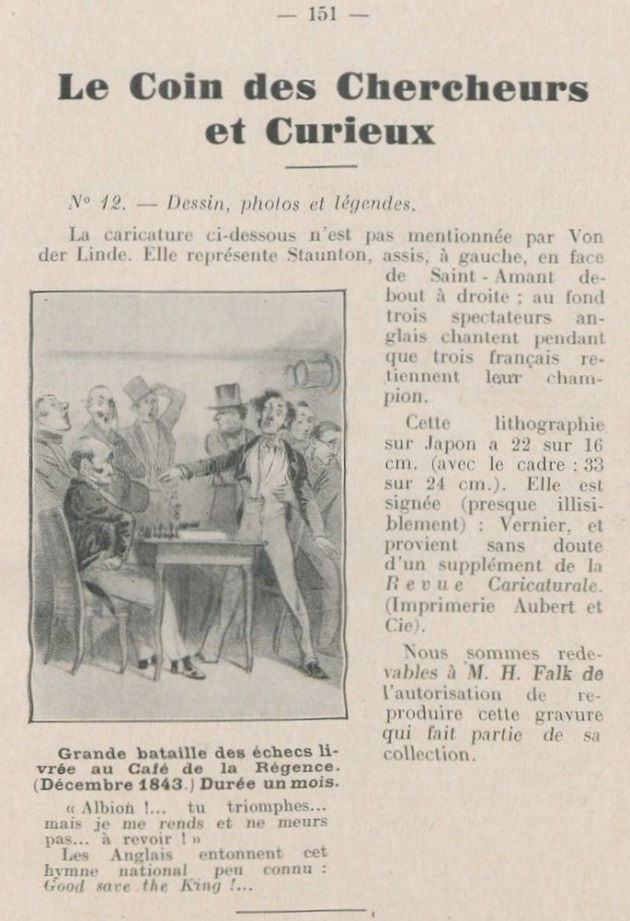
Our correspondent adds:
‘La Revue Caricaturale published the work of major French caricaturists, including the celebrated Honoré Daumier. The chess cartoon, by Charles Vernier, appeared in the 5 January 1844 edition. It is shown on the Bordeaux website Séléné, although with a notice which appears incorrect regarding the place of first publication (not Bordeaux but Paris).’
(12091)
From page 3 of the Newcastle Daily Chronicle, 27 July 1874:
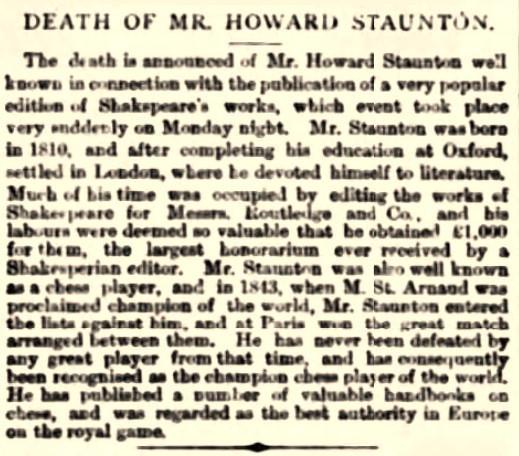
Chess is not mentioned until the latter part of the report, but the statement that Staunton ‘has consequently been recognised as the champion chess player of the world’ is noteworthy and is being added to Early Uses of ‘World Chess Champion’.
(12116)
From page 7 of the Newcastle Courant, 15 December 1876 (chess columnist: William Mitcheson):
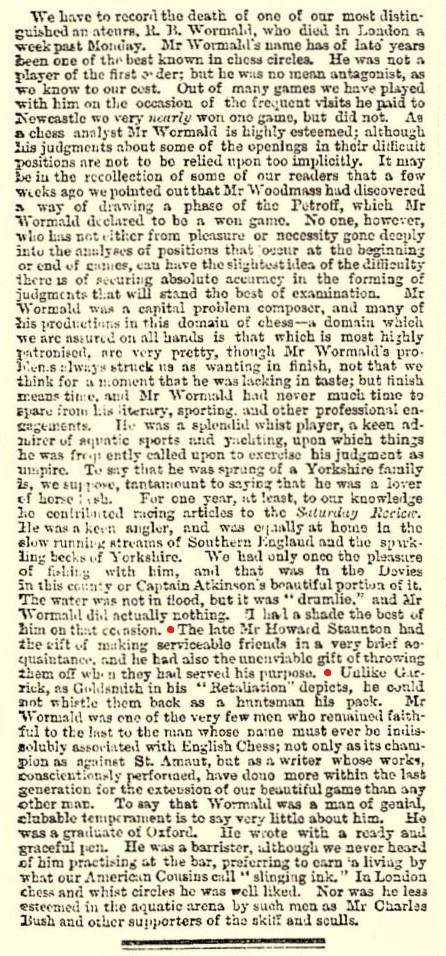
The marked text reads:
‘The late Mr Howard Staunton had the gift of making serviceable friends in a very brief acquaintance, and he had also the unenviable gift of throwing them off when they had served his purpose.’
Does that claim hold up under scrutiny?
(12117)
Further to C.N. 12116, below is the obituary of Howard Staunton on page 4 of The Scotsman, 29 June 1874:

Beyond such curiosities as ‘a native, we believe, of Warwickshire’, ‘educated at Eton and Oxford’ and ‘the conqueror of Murphy’, the text illustrates how mainstream obituaries of Staunton might focus on Shakespeare and not chess. The English-language Wikipedia article on Staunton does the reverse.
Possible reasons for the decline in Staunton’s standing as a Shakespeare authority were given by, in particular, Richard Allen in C.N. 5603 above.
Attacks on Howard Staunton includes chess observations by, among others, Fred Reinfeld, Al Horowitz and Larry Evans. Remarks by Evans are discussed in detail in The Facts about Larry Evans, and here is another one:
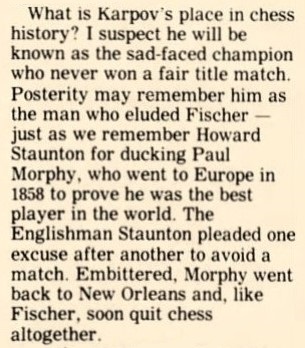
Reno Gazette-Journal, 18 April 1987, page 33
(12127)
C.N.s 12116 and 12127 prompt an addition to Predicaments for Chess Writers: the task of writing just a factual line or two about Howard Staunton’s early (pre-chess) years.
(12140)
From John Townsend:
‘In C.N. 12117, the chess columnist William Mitcheson stated that Howard Staunton “threw off” friendships when they were no longer of service to him. No evidence for his assertion was offered, and no examples were provided.
It cannot be doubted that Staunton made enemies, but the same could be said of other top players who have been world champion or regarded as the world’s best, or who have achieved great fame. The examples of Steinitz and Alekhine spring to mind, while Lasker and Capablanca acquired reputations for making challenges difficult to mount, resulting in tensions. Is there not something special about the position of a champion which provokes envy, rivalry and hostility? They are there to be shot at.
In the case of Staunton, he was, in addition, a forthright man. The art critic Thomas Jefferson Bryan, in comparing him with Saint-Amant, preferred Staunton’s openness and made the following observation:
“Mr Staunton cares not to appear other than he is. I make no pretensions to etiquette, but common sense induces me to prefer his sincerity – and I confess his mode of behaviour is the more pleasing to me – for we cannot accuse him of carrying his politeness to an undue excess.” (Source: Chess Player’s Chronicle, 1846, page 147.)
In a letter to the City of London Chess Magazine (January 1875, pages 12-13), von der Lasa referred to Staunton’s own remarks about his associations with five notable chess figures:
“Staunton’s letter of November last [1873] was altogether written in a most friendly tone, and spoke likewise in affectionate terms of other players. ‘I was sorry’, he wrote, ‘to lose Lewis and St Amant, my dear friends Bolton and Sir F. Madden, and others of whom we have been deprived, but for Jaenisch I entertained a particular affection, and his loss was proportionately painful to me. He was truly an amiable and an upright man.’”
In the case of the problemist Reverend Horatio Bolton, a Norfolk clergyman, he had been a friend since at least 1840, when the two contested a correspondence match, and he was referred to as a friend in a letter as late as 1873, the year of Bolton’s death.
Von der Lasa acknowledged that Staunton was responsible for “animosities” in the world of chess and attributed the cause to “his great irritability of temper”, which resulted from his heart problem.
In the world of Shakespearean studies, Staunton enjoyed a long and rewarding friendship with the scholar James Orchard Halliwell-Phillipps. Their correspondence (see C.N. 11993) ended only with Staunton’s death in 1874, having begun in 1855 or earlier. Their exchanges are respectful and nearly always cordial. These qualities are not diminished by the odd blunt remark made by Staunton; neither is their friendship jeopardized by it.
Finally, it is relevant to mention here his wife Frances, to whom he was married for 25 years. The impression left is that their marriage was harmonious, since no evidence is known that during that time the two of them even quarrelled, let alone had a serious rift.’
(12141)
A small photograph of Mitcheson appears in C.N. 3467.
John Townsend writes:
‘In C.N. 1453 (the July-August 1987 issue of your magazine), the late W.D. Rubinstein raised some pertinent questions regarding the origins of Howard Staunton and his early life. In what follows, these questions are considered again today in the light of discoveries made during the intervening period.
“Is anything more now known about the ancestry of Howard Staunton than when Keene and Coles’ biography appeared in 1975? According to the account in the Oxford Companion to Chess, ‘nothing is known for certain about Staunton’s life before 1836’.”
Nothing more is known for certain, but important clues have come to light in three areas:
1. Staunton has been found on the 1861 and 1871 censuses; in both cases, his place of birth was entered as Keswick (in the county of Cumberland).
In the 1851 census, his birthplace had been recorded as “Westmorland”; that is, the county alone was named, without a village, town or parish, which is unusual.
His age on all three censuses is fairly consistent and suggests birth about 1810.
Westmorland is not strictly consistent with Keswick (Cumberland), although it could be deemed consistent if he was born in a Westmorland parish close to Keswick, since those supplying the census information were encouraged to name the nearest town of consequence.
In my opinion, the information that he was born in Keswick, or Westmorland, though possibly correct, needs to be treated with caution, since Staunton himself is the sole source of it. The same applies to his father being named as William Staunton, gentleman, on his marriage certificate: it may, or may not, be true.
2. There is strong evidence that Howard Staunton was referred to as Charles Staunton, or Charles Stanton, in 1838-39, during the period when he was secretary of the Westminster Chess Club.
Detailed discussion of this last topic appeared in my two books, Notes on the Life of Howard Staunton (pages 1-15) and Historical Notes on Some Chess Players (pages 109-135). For readers who do not have access, in what follows I offer a summary of those discussions.
Chess sources show that during most of 1839, the Westminster Chess Club met at 26 Charles Street, St James’s Square, with Howard Staunton as its secretary. In those days, a “rates” system was operated in England by which the occupiers of property were required to contribute towards various services provided by the parish. 26 Charles Street was divided into several apartments, one of which was occupied by a man named “Charles Staunton” in two rates documents, and spelt “Charles Stanton” on two other occasions. Another source, Robson’s Court Guide (1840 edition) names the occupier as Howard Staunton, Esq., so there is an obvious inference that Charles Stanton/Staunton was a name used at that time by the famous chessplayer.
In addition, Charles Stanton, Esq., was a subscriber to William Greenwood Walker’s 1836 book about the McDonnell v Labourdonnais games. As no other chessplayer by the name of Charles Staunton, or Charles Stanton, is known at that time, it seems likely that this is another reference to Howard Staunton. Some commentators have doubted this conclusion because there is also a separate entry for “H. Staunton, Esq.”. One needs to bear in mind the unusually high frequency of errors in Walker’s book. His namesake, George Walker, described it as “disfigured by ten thousand errors of press”. There are other instances of subscribers appearing twice; for example, on page 280 the members of the Bristol Chess Club are all listed twice, the second list being slightly different. If both entries referred to Staunton, it would mean the name Charles Staunton, or Charles Stanton, was used by him at least during the period 1836-39, perhaps longer, and it may be a clue to his origins. The evidence of the rate-books is strong, not least because they are an official and objective source, and the information they contain is not dependent on Staunton himself, as is the case with certain other sources.
The lives of several individuals by the name of Charles Staunton, or Charles Stanton, have been explored and compared with known facts about Howard Staunton; most have been discarded as impossible or unlikely, though in one or two cases without any certainty.
One clear candidate remains, and there is significant evidence, but no proof, that he was Howard Staunton.
William Charles Stanton is referred to in a land tax document of 1830 (“W.C. Stanton”), when he resided in Motcomb Street, near Belgrave Square. Later he moved to Coleshill Street, and by 1834 was at Selwood Place, Brompton. He had two children with a woman, Mary Frailing, being referred to in 1834 as “Charles Staunton”. The parish register baptism entries read as if the children were born in wedlock, but no evidence of a marriage has been found. Mary Frailing was buried at Brompton on 14 November 1834, referred to as “Mary Fearling Staunton”, aged 25; the cause of her death is not known.
William Charles Stanton continued to appear in the rate books of Brompton for a short time, until September 1835, after which no further information about him is known. My theory is that he became Howard Staunton, who is first mentioned by that name in 1836.
The elder child, Agnes Staunton, went to school in Fulham and was married at Paddington in 1848 at the age of 18, her father being named as “Charles Staunton”. She had several children and died in Naples in 1888.
The other child, Charles Staunton, was brought up at Putney by Jemima Freeling, his aunt. He became an assistant schoolmaster, then a journalist, and later worked for a building society. His literary and historical pursuits resembled those of Staunton, and he submitted several questions to the periodical Notes and Queries. He was a sub-editor of the Oxford English Dictionary. He had an outgoing personality and gave addresses on a variety of subjects. In 1859, he offered himself as a Tory candidate for a parliamentary election in Brighton, in the event that no other candidate could be found. Recently, much more information has come to light about this Charles Staunton’s final years, in Somerset. He died in Taunton in 1867.
A clear link between William Charles Stanton (sometimes referred to as Charles Staunton) and Howard Staunton remains to be established.
3. Since the time of Professor Rubinstein’s query, more has been learned about Staunton’s life between 1845 and 1849. This has included details of addresses where he lived. During 1847 and 1848, he resided at 6½ Park Place, Fulham Road (Chelsea), his landlord being Thomas Tombleson, a builder and a Battle of Trafalgar veteran, who paid the rates there.
I acknowledge gratefully the valued assistance of Liverpool Chess Club, which kindly gave me access to images of certain Staunton letters in their archives.
These included two 1846 letters addressed from 6 Park Place, Fulham Road (Chelsea); it is assumed that 6 was the number before the property was divided into two separate addresses, so, effectively, Staunton’s residence in Park Place has been extended backwards by about one year.
More important is an entirely new address, 15 Brompton Row, Fulham Road, which appears on two 1845 letters owned by the Liverpool Chess Club. This address was in the parish of Brompton, being very close to Knightsbridge. It is his earliest known residence in Brompton. Searches in rate-books and London directories strongly suggest that it was a lodging house at that time. Brompton Row is an interesting street because it was much favoured by actors, an occupation thought to have been pursued by Staunton. Still, there is no proof that Staunton was an actor, despite this and other evidence.
“Have the Westmorland parish registers for the spring of 1810 ever been searched for a record of his birth?”
Births were not routinely recorded in parish registers, although the baptism registers do sometimes include the date of birth.
I am not aware of any factual basis which supports Staunton’s having been born specifically in the spring of 1810. Since the 1861 and 1871 censuses both give Keswick as his place of birth, parish registers for the county of Cumberland need to be considered too.
In C.N. 1471, Ken Whyld noted that he and David Hooper had examined the Westmorland parish registers for every male child born of a father named William in the period March-September 1810.
This search was limited to the county of Westmorland. I am not aware that Whyld published details of this work, hence the sources used are not known. I suspect that the International Genealogical Index was used, in which baptism records are indexed.
In that part of the country at that time, it was common for baptisms to take place many months and sometimes even two or three years after birth. This can be seen clearly in the baptisms of Crosthwaite (which included the town of Keswick). It is insufficient to consider only baptisms during the year 1810; a more realistic approach would be one which covered baptisms between 1810 and 1813, and even then it may be a mistake to assume that Staunton was born in 1810.
The variant Stainton is common in both Cumberland and Westmorland, where Staunton and Stanton are uncommon. I myself have used the International Genealogical Index as a finding aid to studying Staunton, Stanton and Stainton baptisms in the counties of Cumberland and Westmorland, but not in any systematic way. I did not find any Staunton, Stanton or Stainton baptisms that struck me as likely candidates to be Howard Staunton, having paid closer attention to those parishes in the vicinity of Keswick. It cannot be ruled out that his baptism was under a name which is not recognizable as his.
It is worth noting in passing that transcripts of the parish registers of Crosthwaite, which included Keswick, were printed as far as the year 1812: Henry Brierley and Francis Haswell, The Registers of Crosthwaite, 1562-1812, four volumes, Penrith, 1928-31. These include full details of several illegitimate baptisms during 1810 and 1811 which I have tried, without success, to link with Staunton.
“If he was not the illegitimate son of the fifth Earl of Carlisle, how did the rumour arise that he was, given that the Earls of Carlisle were not really household names among the English aristocracy?”
That seems a fair point, although it does not constitute evidence that the fifth Earl of Carlisle was the father. According to Tim Harding in Eminent Victorian Chess Players (page 35), the rumour that Staunton was a natural son of the fifth Earl of Carlisle was first printed in Frederic Boase’s Modern English Biography in 1901. Actually, in Boase it is more a statement of fact, as the word “rumour” is not used: “natural son of 5 earl of Carlisle (1748-1825)”. It is not known where the information came from.
“The fifth Earl (1748-1825) would have been 62 when Staunton was born. According to the Dictionary of National Biography he was a playwright of some note and was Chancery guardian to Lord Byron, which might be of relevance, given Staunton’s literary pursuits. There is no mention of Howard Staunton in his will. Could Staunton possibly have been the illegitimate son not of the fifth Earl, but of one of his sons – for instance of his third son Lord Frederick Howard, who was born in 1785 and was killed at Waterloo? Has any research been done with their wills?”
It is not easy to disprove this. However, the will of (Major) Frederick Howard (National Archives, PROB 11/1578/439) is quite short and mentions no children or anyone who could be interpreted as Howard Staunton.
If one were to fancy a son of the fifth Earl of Carlisle to be Staunton’s father, a better choice would be the sixth Earl, George Howard (1773-1848). He was a prolific begetter of (legitimate) offspring during the periods both before and after 1810, though it is not known whether he also had any illegitimate children. In those days, his title was Viscount Morpeth, as he did not become Earl until 1825. He had close associations with Cumberland, having been MP for the county for a number of years. His will was also very short: he left everything to his son (National Archives, PROB 11/2106/138).
There is no evidence that the fifth Earl or either of his two sons mentioned above was Staunton’s father.’
(12149)
Addition on 3 June 2025:
G.H. Diggle wrote the text below in the June 1982 Newsflash. It was reproduced on page 82 of Chess Characters (Geneva, 1984):
‘The sudden death of R.N. Coles has deprived us of one of the greatest and most versatile British chess authors and historians of this century. He was a profound and tireless researcher who would never accept “hearsay evidence” and who knew where to look for his material. His knowledge of the contents of nineteenth-century chess columns such as the ILN and Bell’s Life was unique. In one of his best works – Battles-Royal of the Chessboard – he unearthed 50 great games, most of which but for him would have been now forgotten. He was equally at home when dealing with such wide-ranging period personalities as Sultan Khan and Howard Staunton. Perhaps his greatest service to chess was the restoration of the latter (after nearly a century of gross neglect) to his rightful place in the chess hierarchy. Bobby Fischer indeed “lent a vital hand” when he included Staunton in his famous “top ten”. But Coles was the real pioneer. Month by month in the BCM of the ’40s he produced his vivid “Hundred Years Ago” lantern slides depicting the great man and his contemporaries and exhuming their long-forgotten games. Previously for whole decades it had been assumed that there was no chess worth playing through between the death of Labourdonnais and the rise of Anderssen. Writers who should have known better relied on Morphy’s juvenile joke about “devilish bad games” and looked no further. Réti, Euwe and Lasker in their great works on the development of chess strategy all ignored Staunton entirely and heaped mountains of gold, frankincense and myrrh on Steinitz as the Messiah. Even Murray called Staunton deficient in imagination and “content to keep to the well-trodden paths”. But this, as Coles and Keene convincingly showed in Howard Staunton, the English World Chess Champion, was just what he didn’t do – for instance, he popularized fianchettoed bishops, previously laughed out of court by Labourdonnais, who nicknamed them “the little chapels”. After Howard Staunton came out in 1975, Coles wrote to the BM: “I am so glad you enjoyed the book. I certainly felt it was worth writing and so did Ray Keene. Indeed we were so much in agreement in our view on Staunton that some of his essay-type game notes became paragraphs in the biography.”
It is curious that the two English writers who have paid Staunton the most attention were Presidents of the Guildford Chess Club (though with an interval of 30 years between them) – P.W. Sergeant (died 1952) and R.N. Coles, of whom the Club (and indeed the chess world) have just been sadly deprived. Both achieved sterling work on Staunton, though each viewed him very differently. “P.W.S.” scrupulously struggled to be fair to him, but it was “R.N.C.’s” imaginative sympathy that really brought the great English player to life.’
Addition on 24 July 2025:
In the report below (The Standard, 15 November 1843, page 4), two sections of particular interest are highlighted:
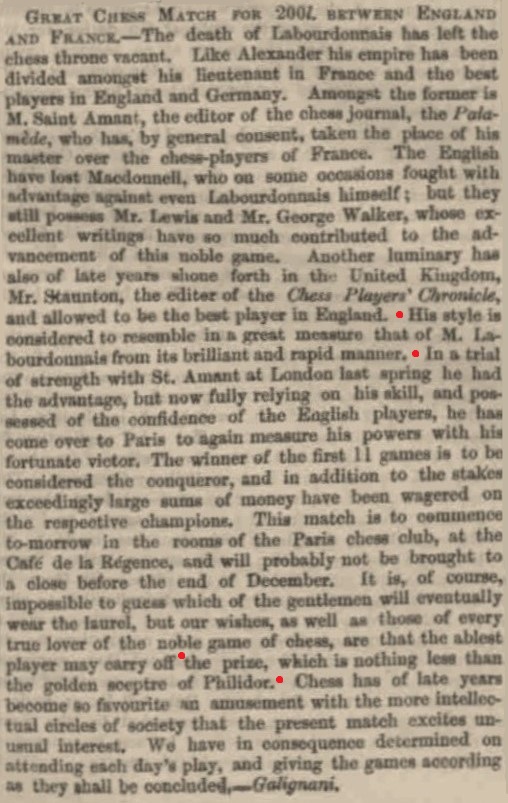
See too Paul Morphy and The Chess Masters of To-day by Leopold Hoffer.
To the Chess Notes main page.
To the Archives for other feature articles.
Copyright: Edward Winter. All rights reserved.